METAL MEXICANO - Tacos, Tequila und Metaleros!
Das Land
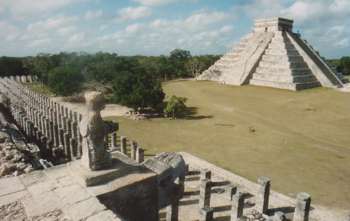 Mexico hat als Land viel zu bieten, von endlosen Kaktuswüsten im Norden bis zu tropischem Dschungel im
Süden. Dazwischen zieht sich in voller Länge das riesige Sierra Madre Gebirge entlang. Heute noch ist es
selbst im Auto mühselig in endlosen Kurven über dieses Hinderniss von Ost nach West zu kommen. Zur
abwechslungsreichen Natur gibt es für jeden Besucher noch unendlich viele historische Sehenswürdigkeiten.
Vor allem die riesigen Ruinenstätten der Mayas und Azteken sind schwer beeindruckend. Das Essen ist
berühmt, wie auch die flüssige Nahrung Tequila und Mezcal (der mit dem Wurm drin!). Das Bier ist über
alle Zweifel erhaben und lässt die Amis im Norden ziemlich alt aussehen. Das Verhältniss zwischen den
beiden Nachbarn ist nicht besonders, was auch nicht verwunderlich ist nachdem die Amis sich riesige
Gebiete incl. Texas und Californien unter den Nagel gerissen haben. Frage nie einen Ami nach Mexico, da
herrscht bei ihnen die nackte Angst und jeder wird dir abraten. Sie kennen auch meistens nur die
Grenzorte die wirklich schlimm sind weil sich der ganze Abschaum dort versammelt um die Amis auszunehmen.
Mexico hat als Land viel zu bieten, von endlosen Kaktuswüsten im Norden bis zu tropischem Dschungel im
Süden. Dazwischen zieht sich in voller Länge das riesige Sierra Madre Gebirge entlang. Heute noch ist es
selbst im Auto mühselig in endlosen Kurven über dieses Hinderniss von Ost nach West zu kommen. Zur
abwechslungsreichen Natur gibt es für jeden Besucher noch unendlich viele historische Sehenswürdigkeiten.
Vor allem die riesigen Ruinenstätten der Mayas und Azteken sind schwer beeindruckend. Das Essen ist
berühmt, wie auch die flüssige Nahrung Tequila und Mezcal (der mit dem Wurm drin!). Das Bier ist über
alle Zweifel erhaben und lässt die Amis im Norden ziemlich alt aussehen. Das Verhältniss zwischen den
beiden Nachbarn ist nicht besonders, was auch nicht verwunderlich ist nachdem die Amis sich riesige
Gebiete incl. Texas und Californien unter den Nagel gerissen haben. Frage nie einen Ami nach Mexico, da
herrscht bei ihnen die nackte Angst und jeder wird dir abraten. Sie kennen auch meistens nur die
Grenzorte die wirklich schlimm sind weil sich der ganze Abschaum dort versammelt um die Amis auszunehmen.
 Ein Stück weg von der Grenze lernt man das normale Leben Mexicos kennen. Vor allem wenn man zu erkennen
gibt das man kein Gringo aus "Estados Unidos" ist, sondern aus Alemania kommt hat man schon mal bessere
Karten. Die Lebensumstände sind ähnlich wie in Argentinien: Korruption überall, Millionenschwerer
Reichtum ganz oben, bitterer Armut ganz unten und nichts dazwischen. Die wenigen hellhäutigen sind
natürlich von der Oberschicht, in der die noch stark indianisch aussehende Mehrheit nicht gerne gesehen
wird. Auch ist Mexico City ein unendlicher Moloch und liegt mit seinem ganzen Dreck und Abgas, von
Bergen umgeben wie in einer riesigen Schüssel in der die meiste Zeit des Jahres dicker Smog herrscht.
Da es auch noch ziemlich hoch liegt und die Luft sowieso ziemlich dünn ist sollten empfindliche Seelen
gar nicht erst dorthin. Hier wird natürlich wie in einem riesigen Schmelztiegel harter Stahl in allen
seinen Varianten gekocht. Durch die extremen Probleme überwiegt aber klar das radikale in Musik und
Texten. Es wird in spanisch und englisch gesungen deshalb trifft man auch ab und zu Leute die englisch
können.
Ein Stück weg von der Grenze lernt man das normale Leben Mexicos kennen. Vor allem wenn man zu erkennen
gibt das man kein Gringo aus "Estados Unidos" ist, sondern aus Alemania kommt hat man schon mal bessere
Karten. Die Lebensumstände sind ähnlich wie in Argentinien: Korruption überall, Millionenschwerer
Reichtum ganz oben, bitterer Armut ganz unten und nichts dazwischen. Die wenigen hellhäutigen sind
natürlich von der Oberschicht, in der die noch stark indianisch aussehende Mehrheit nicht gerne gesehen
wird. Auch ist Mexico City ein unendlicher Moloch und liegt mit seinem ganzen Dreck und Abgas, von
Bergen umgeben wie in einer riesigen Schüssel in der die meiste Zeit des Jahres dicker Smog herrscht.
Da es auch noch ziemlich hoch liegt und die Luft sowieso ziemlich dünn ist sollten empfindliche Seelen
gar nicht erst dorthin. Hier wird natürlich wie in einem riesigen Schmelztiegel harter Stahl in allen
seinen Varianten gekocht. Durch die extremen Probleme überwiegt aber klar das radikale in Musik und
Texten. Es wird in spanisch und englisch gesungen deshalb trifft man auch ab und zu Leute die englisch
können.
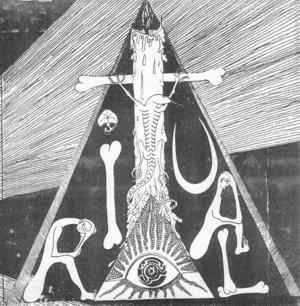
Rock Geschichte
Die Geschichte der Rockmusik in Mexico begann in den 60er Jahren mit Bands die US Rock coverten.
Sie machten sich aber nicht die Arbeit, und übersetzten die Texte, sondern erfanden einfach ihre
eigenen! Erst Ende der 60er tauchten die ersten eigenständigen Bands auf die auch in der eigenen Songs
und Musik hatten, und viele Jugendliche begeistern. Die ersten bekannten sind LA REVOLUTION DE EMILIANO
ZAPATA und es folgen TONCHO PILATOS (mit ersten kritischen Texten) THREE SOULS IN MY MIND (bis heute als
EL TRI die absolute Rock Institution) u.a. Es tauchen auch die ersten härteren Bands auf, die LP von
EL RITUAL (1971) ist guter 70er Hard Rock und NAHUATL`s erste LP von 1975 ist richtig stark und schon
fast heavy (die zweite ist Mist). Woodstock inspiriert die Szene total, und sie organisieren ihr eigenes
Festival "Avandaro" 1971 (mit 150000 Zuschauern). Dort werden die Mißstände angeklagt und gegen die
Regierung gesprochen. Darauf beginnt eine Hexenjagd von Presse und Authoritäten gegen die dreckigen,
drogenabhängigen, kommunistischen und gewalttätigen Rock Fans. Schon nach dem grossen Massaker an
Studenten 1968 (vor den Olympischen Spielen) ist die Regierung gegen Rock Musik. Nun aber wird die ganze
Bewegung unterdrückt, Konzerte verboten , Lokale geschlossen, Rock im Radio verboten und Rock
Zeitschriften zensiert. Die noch kleine Fan Basis zerstreut sich und die Bands lösen sich fast alle auf.
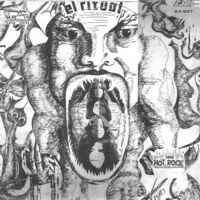 Nur EL TRI und einige wenige andere überleben das Ende der 70er Jahre. Einer der wenigen Plätze, wo man
noch Rock Scheiben bekam, und spielen konnte war das "Hip 70" in Mexico City. Eine andere Band aus
dieser Zeit die auch einigen Einfluss auf die Heavy Szene hat mit ihrem Hard Rock Stil ist ENIGMA,
die Ende der 70er / Anfang der 80er etliche Alben veröffentlichen. 1980 entsteht der "Chopo" Markt und
entwickelt sich zum bis heute wichtigsten Treffpunkt für alles was mit Rock zu tun hat. Solch ein
Meeting und Angebot für Punks, Rocker, Ted`s, und Heavys hab ich noch nirgends gesehen. (Die Punkszene
ist extrem aktiv mit vielen Bands, Konzerten, Veröffentlichungen und sehr schillerndem Outfit). Nur auf
dem Chopo bekommt man z. B. alte Vinyl LP`s, Demos und Eigenproduktionen. Der Name kommt vom "Museo
cultural del Chopo" am ursprünglichen Standort, er ist aber mehrmals in der näheren Gegend umgezogen.
Nur EL TRI und einige wenige andere überleben das Ende der 70er Jahre. Einer der wenigen Plätze, wo man
noch Rock Scheiben bekam, und spielen konnte war das "Hip 70" in Mexico City. Eine andere Band aus
dieser Zeit die auch einigen Einfluss auf die Heavy Szene hat mit ihrem Hard Rock Stil ist ENIGMA,
die Ende der 70er / Anfang der 80er etliche Alben veröffentlichen. 1980 entsteht der "Chopo" Markt und
entwickelt sich zum bis heute wichtigsten Treffpunkt für alles was mit Rock zu tun hat. Solch ein
Meeting und Angebot für Punks, Rocker, Ted`s, und Heavys hab ich noch nirgends gesehen. (Die Punkszene
ist extrem aktiv mit vielen Bands, Konzerten, Veröffentlichungen und sehr schillerndem Outfit). Nur auf
dem Chopo bekommt man z. B. alte Vinyl LP`s, Demos und Eigenproduktionen. Der Name kommt vom "Museo
cultural del Chopo" am ursprünglichen Standort, er ist aber mehrmals in der näheren Gegend umgezogen.
Metal Geschichte
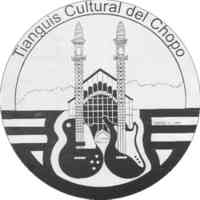 Anfang der 80er kommt auch die Metal Welle bis Mexico und erste Bands entstehen, covern aber erstmal nur.
Als erstes sind die grossen britischen Bands angesagt, und die SCORPIONS. Dann, als die ersten US Bands
bekannt werden, sind sie natürlich ein grosser Einfluss. Die ersten mexikanischen Bands entstehen auch
an der Grenzregion zur USA, da dort einfach die Versorgung mit Rock Musik besser ist (z.B. CRAZY LAZY
in Monterrey und DEATH WARRANT in Ciudad Juarez). Mitte der 80er spielen überall ersten Bands
eigenständige Sachen und eine eingeschworene Fan Szene entsteht die nichts anderes akzeptiert. Im
Gegensatz zu Argentinien entwickeln sich auch ausserhalb der Hauptstadt eigene aktive Szenen von denen
einige sogar LP`s veröffentlichen. CRAZY LAZY aus Monterrey sind mit ihrer Eigenproduktion sogar fast
die ersten Metaller die eine LP veröffentlichen. Als Spezialität der mexikanischen Metal Szene
entwickelt sich, eine völlig eigene Art von Slam Dance: In der Mitte steht der Hardcore Kern und bangt
was das Zeug hält und um sie herum kreisen in wilden Sprüngen die anderen. Das ganze erinnert an
indianische Tänze und ist nicht so unkontrolliert und aggressiv wie manchmal bei uns, und man sieht
auch viele Mädchen die mitmachen. Auffällig sind auch die vielen "Metalbrothers" im wahrsten Sinne des
Wortes, denn zwei Brüder pro Band sind schon fast normal und 3 keine Seltenheit und SIX BEER sind später
gar ein reines Familienunternehmen mit 4 Brüdern gewesen. Interessant ist auch, dass viele Heavy Musiker
zu der Zeit geschminkt und mit ausgefallenen Klamotten rumliefen. Die erste Welle der Metalbands singt
fast nur in spanisch, aber bis Ende der 80er setzt sich englisch immer mehr durch.
Anfang der 80er kommt auch die Metal Welle bis Mexico und erste Bands entstehen, covern aber erstmal nur.
Als erstes sind die grossen britischen Bands angesagt, und die SCORPIONS. Dann, als die ersten US Bands
bekannt werden, sind sie natürlich ein grosser Einfluss. Die ersten mexikanischen Bands entstehen auch
an der Grenzregion zur USA, da dort einfach die Versorgung mit Rock Musik besser ist (z.B. CRAZY LAZY
in Monterrey und DEATH WARRANT in Ciudad Juarez). Mitte der 80er spielen überall ersten Bands
eigenständige Sachen und eine eingeschworene Fan Szene entsteht die nichts anderes akzeptiert. Im
Gegensatz zu Argentinien entwickeln sich auch ausserhalb der Hauptstadt eigene aktive Szenen von denen
einige sogar LP`s veröffentlichen. CRAZY LAZY aus Monterrey sind mit ihrer Eigenproduktion sogar fast
die ersten Metaller die eine LP veröffentlichen. Als Spezialität der mexikanischen Metal Szene
entwickelt sich, eine völlig eigene Art von Slam Dance: In der Mitte steht der Hardcore Kern und bangt
was das Zeug hält und um sie herum kreisen in wilden Sprüngen die anderen. Das ganze erinnert an
indianische Tänze und ist nicht so unkontrolliert und aggressiv wie manchmal bei uns, und man sieht
auch viele Mädchen die mitmachen. Auffällig sind auch die vielen "Metalbrothers" im wahrsten Sinne des
Wortes, denn zwei Brüder pro Band sind schon fast normal und 3 keine Seltenheit und SIX BEER sind später
gar ein reines Familienunternehmen mit 4 Brüdern gewesen. Interessant ist auch, dass viele Heavy Musiker
zu der Zeit geschminkt und mit ausgefallenen Klamotten rumliefen. Die erste Welle der Metalbands singt
fast nur in spanisch, aber bis Ende der 80er setzt sich englisch immer mehr durch.
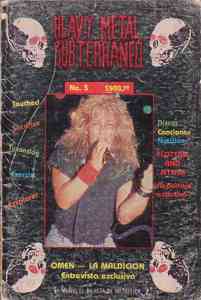 Mitte der 80er wachen auch die ersten Plattenfirmen auf. "Comrock" nimmt LUZBEL und RAMSES unter Vertrag,
gehen aber bald Pleite, und werden von WEA geschluckt. Die Leute dort waren einfach zu unerfahren mit
dieser Art von Musik. Überhaupt fehlt die totale Infrastruktur, und alles ist noch ziemlich unorganisiert .
Aber 1986 setzen sich einige Bandmitglieder (Gustavo Solis von RAMSES; Arturo Huizar von LUZBEL und
Daniel Ojeda von CARONTE), Presseleute (Georgui Lazarov und Carlos Hernandez) und einige Fans zusammen
und gründen die "Escuadron Metalica". Sie wollen die Metalszene in allen Belangen unterstützen, vor
allem gemeinsame Konzerte veranstalten und Promotion machen, weshalb sie 1986 den Sampler "Escuadron
Metalica" herausbringen. Auf diesem spielen die neuen Metalhoffnungen GEHENNA; KHAFRA; Z und ASPID.
Diese Scheibe erschien auf dem Label "Discos Rosenbach", welches dem Drummer Victor Baldorinos von den
Prog Rockern ICONOCLAST gehört, der auch der offizielle Produzent der "Escuadron" ist. Alle anderen
wichtigen Bands der Zeit waren auch Mitglieder, wie z.B. ULTIMATUM: APOCALIPSIS; MEGATON und viele die
es nur zu einem Demo brachten wie DEATH WARRANT; VIRGIN WITCH; SUPER ALFA; ABADDON; ALUCARD; AUSTER und
viele mehr. Lazarov (ein ausgewanderter Bulgare) und Carlos F. Hernandez engagieren sich aber noch
weiter, und gründen das "Heavy Metal Subterraneo" Fanzine (die ersten 4 Nummern als Beilage zur Musik
Zeitschrift "Connecte", bei der sie arbeiteten). Sie gründen auch das "Avanzada Metalica" Label, das die
"Escuadron Metalico" Serie fortführt, und vielen neuen Bands eine Chance gibt, und ihre Platten
herausbringt (TRANSMETAL; NEXT; INQUISIDOR; Z; KHAFRA und mehr).
Mitte der 80er wachen auch die ersten Plattenfirmen auf. "Comrock" nimmt LUZBEL und RAMSES unter Vertrag,
gehen aber bald Pleite, und werden von WEA geschluckt. Die Leute dort waren einfach zu unerfahren mit
dieser Art von Musik. Überhaupt fehlt die totale Infrastruktur, und alles ist noch ziemlich unorganisiert .
Aber 1986 setzen sich einige Bandmitglieder (Gustavo Solis von RAMSES; Arturo Huizar von LUZBEL und
Daniel Ojeda von CARONTE), Presseleute (Georgui Lazarov und Carlos Hernandez) und einige Fans zusammen
und gründen die "Escuadron Metalica". Sie wollen die Metalszene in allen Belangen unterstützen, vor
allem gemeinsame Konzerte veranstalten und Promotion machen, weshalb sie 1986 den Sampler "Escuadron
Metalica" herausbringen. Auf diesem spielen die neuen Metalhoffnungen GEHENNA; KHAFRA; Z und ASPID.
Diese Scheibe erschien auf dem Label "Discos Rosenbach", welches dem Drummer Victor Baldorinos von den
Prog Rockern ICONOCLAST gehört, der auch der offizielle Produzent der "Escuadron" ist. Alle anderen
wichtigen Bands der Zeit waren auch Mitglieder, wie z.B. ULTIMATUM: APOCALIPSIS; MEGATON und viele die
es nur zu einem Demo brachten wie DEATH WARRANT; VIRGIN WITCH; SUPER ALFA; ABADDON; ALUCARD; AUSTER und
viele mehr. Lazarov (ein ausgewanderter Bulgare) und Carlos F. Hernandez engagieren sich aber noch
weiter, und gründen das "Heavy Metal Subterraneo" Fanzine (die ersten 4 Nummern als Beilage zur Musik
Zeitschrift "Connecte", bei der sie arbeiteten). Sie gründen auch das "Avanzada Metalica" Label, das die
"Escuadron Metalico" Serie fortführt, und vielen neuen Bands eine Chance gibt, und ihre Platten
herausbringt (TRANSMETAL; NEXT; INQUISIDOR; Z; KHAFRA und mehr).
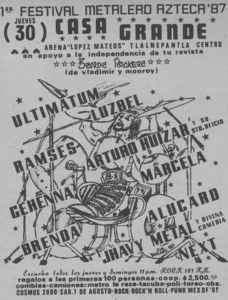 Ab 1986 gibt es immer mehr Metal
Konzerte und ab 1987 mit dem "Festival Metalero Azteca" das erste Grossereigniss mit allem was Rang und
Namen hat. Lazarov und Hernandez veranstalten Metal Video Shows mit anschliessenden Konzerten, die in
den nächsten Jahren einen wichtigen Schub in die Szene bringen. 1988 kommen die ersten ausländischen
Bands, die allerersten sind 3 dralle Latinas aus der alten heimischen Provinz Texas die sich HEATHER
LEATHER nennen (von denen gibt's eine ultrarare Single von 1987). Es folgen V. RUMORS, DEATH, A. DEL
INFIERNO und mehr, auch wird 1988 das absolute Festivaljahr mit mehreren Treffen die nun jedes Jahr
folgen. Gegen die immer noch üblichen Übergriffe und Razzien der Polizei und die immer drohene
Schliessung des Chopo Marktes gibt es jedes Jahr in mehreren Städten Demos und Veranstaltungen. Extrem
schneller Thrash Metal mit brutalen oder anklagenden Texten, wie ihn TRANSMETAL; INQUISIDOR; NEXT;
LEPROSY und andere spielen wird sehr beliebt. Es gibt aber auch hier für lange Zeit diese räudigen
Poserbands, z.B. MARA und VAGO. Erstaunlich, und weltweit wohl einmalig ist aber, dass bei vielen
kleinen Festivals ("Chancoques" genannt) diese Bands problemlos mit den Metal Bands oder sogar den
extremen Thrash Bands zusammen spielen, und auch die verschiedenen Fans keine Probleme untereinander
haben. Selbst reine Rock Bands wie EL TRI spielen manchmal mit extremen Metal Bands zusammen! In Mexico
erscheinen sogar einige echt geile US Bands allein hier auf Platte und CD (natürlich bei "Avanzada").
Ab 1986 gibt es immer mehr Metal
Konzerte und ab 1987 mit dem "Festival Metalero Azteca" das erste Grossereigniss mit allem was Rang und
Namen hat. Lazarov und Hernandez veranstalten Metal Video Shows mit anschliessenden Konzerten, die in
den nächsten Jahren einen wichtigen Schub in die Szene bringen. 1988 kommen die ersten ausländischen
Bands, die allerersten sind 3 dralle Latinas aus der alten heimischen Provinz Texas die sich HEATHER
LEATHER nennen (von denen gibt's eine ultrarare Single von 1987). Es folgen V. RUMORS, DEATH, A. DEL
INFIERNO und mehr, auch wird 1988 das absolute Festivaljahr mit mehreren Treffen die nun jedes Jahr
folgen. Gegen die immer noch üblichen Übergriffe und Razzien der Polizei und die immer drohene
Schliessung des Chopo Marktes gibt es jedes Jahr in mehreren Städten Demos und Veranstaltungen. Extrem
schneller Thrash Metal mit brutalen oder anklagenden Texten, wie ihn TRANSMETAL; INQUISIDOR; NEXT;
LEPROSY und andere spielen wird sehr beliebt. Es gibt aber auch hier für lange Zeit diese räudigen
Poserbands, z.B. MARA und VAGO. Erstaunlich, und weltweit wohl einmalig ist aber, dass bei vielen
kleinen Festivals ("Chancoques" genannt) diese Bands problemlos mit den Metal Bands oder sogar den
extremen Thrash Bands zusammen spielen, und auch die verschiedenen Fans keine Probleme untereinander
haben. Selbst reine Rock Bands wie EL TRI spielen manchmal mit extremen Metal Bands zusammen! In Mexico
erscheinen sogar einige echt geile US Bands allein hier auf Platte und CD (natürlich bei "Avanzada").
 Ende der 80er nehmen die Labels "Denver" und "Gas" viele Metal Bands unter Vertrag. Fast alle Scheiben
von "Gas Discos" sind selten, da bei denen alles nach einer Weile alles weggeschmissen wurde was nicht
verkauft wurde. Anfang der 90er kommen erst die ersten richtig grossen internationalen Metal Bands.
Pech hatten 1990 OBUS aus Spanien, nur wenige kamen zu ihren Konzerten da gerade ein anderer auf Tournee
war - der Papst! Extremerer Metal wird immer beliebter, Texte und Motive aus der blutigen Azteken- und
Mayazeit bieten sich ja auch ideal für Death Metal Bands an. Mitte der 90er wächst die Szene
Lateinamerikas immer mehr zusammen (durch MTV- Latino??). TRANSMETAL (die seit Ende der 80er zur
grössten Mexikanischen Band wurden) touren in anderen Latino Ländern (inkl. den US- Städten mit grossem
Latino Anteil), und Bands von dort kommen nach Mexico. 1996 gibt es das riesige "Festival
Latinoamericano" mit Bands aus Argentinien (MALON), Chile (CRIMINAL), Uruguay (INNER SANCTUM) u.s.w. Auch gibt es zum 10 jährigen
bestehen des "Heavy Metal Subterraneo" Fanzines das ultimative Festival mit 31 einheimischen Bands.
Ende der 80er nehmen die Labels "Denver" und "Gas" viele Metal Bands unter Vertrag. Fast alle Scheiben
von "Gas Discos" sind selten, da bei denen alles nach einer Weile alles weggeschmissen wurde was nicht
verkauft wurde. Anfang der 90er kommen erst die ersten richtig grossen internationalen Metal Bands.
Pech hatten 1990 OBUS aus Spanien, nur wenige kamen zu ihren Konzerten da gerade ein anderer auf Tournee
war - der Papst! Extremerer Metal wird immer beliebter, Texte und Motive aus der blutigen Azteken- und
Mayazeit bieten sich ja auch ideal für Death Metal Bands an. Mitte der 90er wächst die Szene
Lateinamerikas immer mehr zusammen (durch MTV- Latino??). TRANSMETAL (die seit Ende der 80er zur
grössten Mexikanischen Band wurden) touren in anderen Latino Ländern (inkl. den US- Städten mit grossem
Latino Anteil), und Bands von dort kommen nach Mexico. 1996 gibt es das riesige "Festival
Latinoamericano" mit Bands aus Argentinien (MALON), Chile (CRIMINAL), Uruguay (INNER SANCTUM) u.s.w. Auch gibt es zum 10 jährigen
bestehen des "Heavy Metal Subterraneo" Fanzines das ultimative Festival mit 31 einheimischen Bands.
 Das alles sollte nicht darüber hinwegtäuschen dass die Metal Szene heute hauptsächlich aus Death / Black
Metal Bands besteht (oder alten Thrash Bands die mittlerweile so heftig sind daß man es fast schon als
Daeth Metal bezeichnen kann). Traditionelle Metal Bands musste man Mitte der 90er mit der Lupe im
Untergrund suchen aber es gab sie noch (im Gegensatz zum Bericht im "Iron Pages" Nr. 2/98).
Auch gibt es immer noch LUZBEL
(als letzte Band aus der Anfangszeit), aber sie haben bei weitem nicht mehr die Bedeutung wie früher.
Dafür wurde eine andere Band sozusagen mexikanisch. 2 Leute von ANGELOS DEL INFIERNO
sind nach einigen umjubelten Tourneen Mitte der 90er ganz von Spanien nach Mexico gezogen und nach
Integration von 2 mexikanischen Leuten dort Live sehr aktiv gewesen (sie sind aber mittlerweile
in die USA weitergezogen) Auch war die Band von AGENT STEEL Gitarrist Juan Garcia, TERROR
hauptsächlich in der alten Heimat Mexico aktiv. Obwohl ich zugeben muss, dass viele von den
neuen mexikanischen Death Metal Bands sehr gut sind, habe ich immer gehofft, dass True Metal
dort wieder mehr Bedeutung bekommen wird. Seit ca. 2000 sieht es auch schon wieder besser aus!
In den letzten Jahren kamen interessante CDs heraus, wie z.B. CALVARIO; SANTO OFICIO;
PROYECTO MILENIUM; EROGENA; ANDARTA; ALIOTH; ARGOS und mehr. Auch die alte progressiv Band IRA
wurde eine echte Power Kapelle. Es wurden auch viele alte Alben auf CD wiederveröffentlicht,
wie RAMSES; MEGATON; SIX BEER; NEXT; KHAFRA und andere!
Das alles sollte nicht darüber hinwegtäuschen dass die Metal Szene heute hauptsächlich aus Death / Black
Metal Bands besteht (oder alten Thrash Bands die mittlerweile so heftig sind daß man es fast schon als
Daeth Metal bezeichnen kann). Traditionelle Metal Bands musste man Mitte der 90er mit der Lupe im
Untergrund suchen aber es gab sie noch (im Gegensatz zum Bericht im "Iron Pages" Nr. 2/98).
Auch gibt es immer noch LUZBEL
(als letzte Band aus der Anfangszeit), aber sie haben bei weitem nicht mehr die Bedeutung wie früher.
Dafür wurde eine andere Band sozusagen mexikanisch. 2 Leute von ANGELOS DEL INFIERNO
sind nach einigen umjubelten Tourneen Mitte der 90er ganz von Spanien nach Mexico gezogen und nach
Integration von 2 mexikanischen Leuten dort Live sehr aktiv gewesen (sie sind aber mittlerweile
in die USA weitergezogen) Auch war die Band von AGENT STEEL Gitarrist Juan Garcia, TERROR
hauptsächlich in der alten Heimat Mexico aktiv. Obwohl ich zugeben muss, dass viele von den
neuen mexikanischen Death Metal Bands sehr gut sind, habe ich immer gehofft, dass True Metal
dort wieder mehr Bedeutung bekommen wird. Seit ca. 2000 sieht es auch schon wieder besser aus!
In den letzten Jahren kamen interessante CDs heraus, wie z.B. CALVARIO; SANTO OFICIO;
PROYECTO MILENIUM; EROGENA; ANDARTA; ALIOTH; ARGOS und mehr. Auch die alte progressiv Band IRA
wurde eine echte Power Kapelle. Es wurden auch viele alte Alben auf CD wiederveröffentlicht,
wie RAMSES; MEGATON; SIX BEER; NEXT; KHAFRA und andere!
Mittlerweile entwickeln sich auch andere Zentren neben Mexico City. Im Norden tut sich sehr viel,
vor allem in Monterrey. Es gibt dort viele neue Bands aller Richtungen, und seit 2004 wird das
"Monterrey Fest" veranstaltet. Auf diesem spielten gleich etliche Rock Giganten wie TWISTED
SISTER, aber auch viele mexikanische Bands. Ich habe etliche Mails von Leuten aus dem Norden
Mexicos erhalten, die sich darüber beschweren, dass ich kaum Bands vom Norden erwähne. Einige
davon waren richtige Hass Mails. Auf Anfrage mir dann doch einiges Material dieser vielen Bands
zu schicken kam meistens nichts! Solche agressiven Spinner könen mir gestohlen bleiben!
In den letzten Jahren
Auf den internationalen Trendzug sind auch allerhand Bands aufgesprungen und man sollte z.B.
folgende als True Metal Fan meiden:
LENGUAS MUERTAS; MALICIOUS PROPHECY; SEDICION; AKBAL; PARASITE; DESARMADOR und viele mehr. Alle
relevanten Kapellen für den Leser dieser metallenen Seiten hoffe ich ziemlich komplett aufzählen zu
können
REPORT FROM THE COUNTRY OF TACOS, TEQUILA..... AND METALEROS!
 The country of Mexico has much to offer, from deserts full of cactus in the north, to tropical jungles
in the south. Situated in between are the Sierra Madre mountains. Still today it is hard to travel the
endless bends of the roads over this obstacle in a car. The visitor awaits not only great nature, but
also hundreds of historic sites. Especially the ruins of the Aztec and Maya time are very impressive.
The spicy food and the drinks, like Tequila and Mezcal (with the worm in the bottle) are famous. The
beer is very good, and much better than the ones from the Anglo Americans! The relationship with their
northern neighbors is not very good, which is no wonder, as the USA took huge territories from them,
including Texas, Arizona and California. Never ask an US American about travelling in Mexico! They all
will advice you not to do it, as they are very afraid of this country. Most of them know only the border
towns, who are really bad and full of crooks who try to rip-off tourists. But if you travel further
inland you will get to know the real life, and the friendliness of Mexican people. Especially when they
see that you aren't a "Gringo" from the US, you will have less problems.
The country of Mexico has much to offer, from deserts full of cactus in the north, to tropical jungles
in the south. Situated in between are the Sierra Madre mountains. Still today it is hard to travel the
endless bends of the roads over this obstacle in a car. The visitor awaits not only great nature, but
also hundreds of historic sites. Especially the ruins of the Aztec and Maya time are very impressive.
The spicy food and the drinks, like Tequila and Mezcal (with the worm in the bottle) are famous. The
beer is very good, and much better than the ones from the Anglo Americans! The relationship with their
northern neighbors is not very good, which is no wonder, as the USA took huge territories from them,
including Texas, Arizona and California. Never ask an US American about travelling in Mexico! They all
will advice you not to do it, as they are very afraid of this country. Most of them know only the border
towns, who are really bad and full of crooks who try to rip-off tourists. But if you travel further
inland you will get to know the real life, and the friendliness of Mexican people. Especially when they
see that you aren't a "Gringo" from the US, you will have less problems.
 The life is the same as in most
Latin American countries. You have on one hand very rich people and on the other very poor, and almost
nothing in between. The few pale skinned people are of course from the upper class, and don't like
people from the dark skinned, Indian looking majority in their midst. Mexico city is a gigantic
metropolis, surrounded by high mountains like a bowl, and all the pollution smog stays in there most of
the year. The altitude is also very high, and because of this the air is thinner, so, sensitive souls
should stay away. This is also like a big melting pot for hard steel in all its variations. Because of
the extreme problems the radical music and lyrics prevail. Bands sing in Spanish and English, and you
can find more people who speak English, than in other Latin American countries.
The life is the same as in most
Latin American countries. You have on one hand very rich people and on the other very poor, and almost
nothing in between. The few pale skinned people are of course from the upper class, and don't like
people from the dark skinned, Indian looking majority in their midst. Mexico city is a gigantic
metropolis, surrounded by high mountains like a bowl, and all the pollution smog stays in there most of
the year. The altitude is also very high, and because of this the air is thinner, so, sensitive souls
should stay away. This is also like a big melting pot for hard steel in all its variations. Because of
the extreme problems the radical music and lyrics prevail. Bands sing in Spanish and English, and you
can find more people who speak English, than in other Latin American countries.
ROCK HISTORY
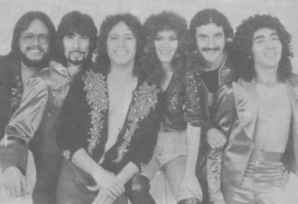 The history of Rock music in Mexico started in the 60s with bands who covered US Rock. But most of this
bands did not know English and did not border with translation of the lyrics, they just wrote their own
lyrics for the songs. End of the 60s the first independent bands appeared with their own songs, and in
Spanish language, which aroused the enthusiasm of the youth. The first who got really known was LA
REVOLUTION DE EMILIANO ZAPATA. They were followed by TONCHO PILATOS (with the first critical lyrics),
THREE SOULS IN MY MIND (till today under the name EL TRI the absolute Rock institution) and more. The
first heavier bands came with EL RITUAL (the first LP 1971 is good Hard Rock) and NAHUATL (their first
LP 1975 is really good and for its time absolutely heavy, the second is bad). Woodstock inspired their
own scene very much and they organized their own festival "Avandaro" 1971 (with 150 000 audience). Here
on stage they agitated against the government and the misery. The government waited already for a reason
like that, and started together with the media a witch hunt against the "dirty, drug addicted,
communistic and violent" Rock fans.
The history of Rock music in Mexico started in the 60s with bands who covered US Rock. But most of this
bands did not know English and did not border with translation of the lyrics, they just wrote their own
lyrics for the songs. End of the 60s the first independent bands appeared with their own songs, and in
Spanish language, which aroused the enthusiasm of the youth. The first who got really known was LA
REVOLUTION DE EMILIANO ZAPATA. They were followed by TONCHO PILATOS (with the first critical lyrics),
THREE SOULS IN MY MIND (till today under the name EL TRI the absolute Rock institution) and more. The
first heavier bands came with EL RITUAL (the first LP 1971 is good Hard Rock) and NAHUATL (their first
LP 1975 is really good and for its time absolutely heavy, the second is bad). Woodstock inspired their
own scene very much and they organized their own festival "Avandaro" 1971 (with 150 000 audience). Here
on stage they agitated against the government and the misery. The government waited already for a reason
like that, and started together with the media a witch hunt against the "dirty, drug addicted,
communistic and violent" Rock fans.
 Already after the big massacre against students at the Olympic games
1968 (with hundreds of victims) the government fought against Rock music. But now the whole scene got
oppressed, concerts were forbidden, clubs closed, Rock in Radio was forbidden, Rock magazines censored
and so forth. This really killed the scene, who was not very big at this time, and many bands quit.
One of the only places where you could get Rock records and could play was the "Hip 70" shop in Mexico City.
Only EL TRI and a few other bands survived to the end of the 70s. Another band from this time who had a
big influence at the Heavy scene was ENIGMA, who made end of the 70s / beginning of the 80s several
progressive Hard Rock albums. In 1980 started the "Chopo" flea market which developed into the most
important meeting and dealing point for everything that had to do with Rock music. It still exists today
and you can see Rockers, Heavys, Punks and Teds, and only there you will get old vinyl LPs, independent
CDs, demo stuff, fanzines and more. The name comes from the "Museo cultural del Chopo", where it started
first, but has now moved several times in the neigbourhood.
Already after the big massacre against students at the Olympic games
1968 (with hundreds of victims) the government fought against Rock music. But now the whole scene got
oppressed, concerts were forbidden, clubs closed, Rock in Radio was forbidden, Rock magazines censored
and so forth. This really killed the scene, who was not very big at this time, and many bands quit.
One of the only places where you could get Rock records and could play was the "Hip 70" shop in Mexico City.
Only EL TRI and a few other bands survived to the end of the 70s. Another band from this time who had a
big influence at the Heavy scene was ENIGMA, who made end of the 70s / beginning of the 80s several
progressive Hard Rock albums. In 1980 started the "Chopo" flea market which developed into the most
important meeting and dealing point for everything that had to do with Rock music. It still exists today
and you can see Rockers, Heavys, Punks and Teds, and only there you will get old vinyl LPs, independent
CDs, demo stuff, fanzines and more. The name comes from the "Museo cultural del Chopo", where it started
first, but has now moved several times in the neigbourhood.
METAL HISTORY
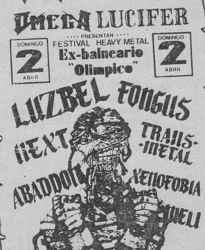 Beginning of the 80s the Metal wave arrived also in Mexico, but the first bands played only cover songs.
First the big English bands and the SCORPIONS became popular, and when the US scene started they loved
the bands from there. The big Mexican cities at the border to the USA herd all this stuff first, and
because of that had some of the first Metal bands in the country. Two of them were CRAZY LAZY from
Monterrey and DEATH WARRANT from Ciudad Juarez. By the mid 80s appeared the first bands that played
their own material, and a fan scene developed, who was very radical and didn't accept anything else.
Contrary to other Latin countries they had also active scenes outside of the capital. One of the first
who made an album, and did it even independently was CRAZY LAZY from Monterey. A unique Mexican Metal
slam dance developed at live concerts: in the middle is the hard core center which bangs and screams,
and around in a circles is a wild jumping and dancing crowd. This reminds a lot of the old Indian dances,
and is not as violent as the "pit" in Europe or the US. You can even see a lot of girls in the crowd.
Unique are also the many "Metal brothers", as in many bands two or 3 brothers are no rarity, and SIX BEERS
had even 4 brothers! Many bands at that time used make-up, and had very strange outfit.
Beginning of the 80s the Metal wave arrived also in Mexico, but the first bands played only cover songs.
First the big English bands and the SCORPIONS became popular, and when the US scene started they loved
the bands from there. The big Mexican cities at the border to the USA herd all this stuff first, and
because of that had some of the first Metal bands in the country. Two of them were CRAZY LAZY from
Monterrey and DEATH WARRANT from Ciudad Juarez. By the mid 80s appeared the first bands that played
their own material, and a fan scene developed, who was very radical and didn't accept anything else.
Contrary to other Latin countries they had also active scenes outside of the capital. One of the first
who made an album, and did it even independently was CRAZY LAZY from Monterey. A unique Mexican Metal
slam dance developed at live concerts: in the middle is the hard core center which bangs and screams,
and around in a circles is a wild jumping and dancing crowd. This reminds a lot of the old Indian dances,
and is not as violent as the "pit" in Europe or the US. You can even see a lot of girls in the crowd.
Unique are also the many "Metal brothers", as in many bands two or 3 brothers are no rarity, and SIX BEERS
had even 4 brothers! Many bands at that time used make-up, and had very strange outfit.
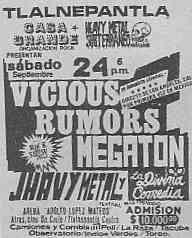 The first wave of
Metal bands sung almost all in Spanish, but by the end of the 80s more and more used English.
The first record companies woke up too, and "Comrock" signed LUZBEL and RAMSES, but soon went bankrupt,
and WEA swallowed them. They were too unexperienced with Metal bands, as the whole new scene was. To
change this some band members (Gustavo Solis from RAMSES; Arturo Huizar from LUZBEL and Daniel Ojeda
from CARONTE), some guys from the Rock media (Georgui Lazarov and Carlos Hernandez) and some fans
founded the "Escuadron Metalico" in 1986. They planned to organize concerts, and to promote Metal bands
in any way possible. One idea was to release the compilation LP "Escuadron Metalica" in the same year,
with the new Metal hopefuls GEHENNA; KHAFRA and ASPID. It was released on the label "Discos Rosenbach"
which was owned by the drummer Victor Baldorinos from the Prog Rock band ICONOCLAST, who was also the
official producer of the "Escuadron". Most of the other important bands from this time were also
members, like ULTIMATUM; APOCALIPSIS; MEGATON and many more, who were only able to release demos, like
DEATH WARRANT; VIRGIN WITCH; SUPER ALFA; ABADDON; ALUCARD; AUSTER; ASPID. Lazarov (who immigrated from
Bulgaria) and Hernandez were even more active and founded their own label "Avanzada Metalica" which
continued with 2 more "Escuadron Metalica" compilations, and released a lot of records from the new
wave of popular bands like TRANSMETAL; NEXT; INQUISIDOR; Z; KHAFRA; GEHENNA and many more. They also
founded the first real Metal fanzine "Heavy Metal Suzbterraneo, which was first an supplement to the
"Connecte" Rock magazine, where the 2 guys worked. Starting with number 5 it was independent and became
one of the best fanzines in the world.
The first wave of
Metal bands sung almost all in Spanish, but by the end of the 80s more and more used English.
The first record companies woke up too, and "Comrock" signed LUZBEL and RAMSES, but soon went bankrupt,
and WEA swallowed them. They were too unexperienced with Metal bands, as the whole new scene was. To
change this some band members (Gustavo Solis from RAMSES; Arturo Huizar from LUZBEL and Daniel Ojeda
from CARONTE), some guys from the Rock media (Georgui Lazarov and Carlos Hernandez) and some fans
founded the "Escuadron Metalico" in 1986. They planned to organize concerts, and to promote Metal bands
in any way possible. One idea was to release the compilation LP "Escuadron Metalica" in the same year,
with the new Metal hopefuls GEHENNA; KHAFRA and ASPID. It was released on the label "Discos Rosenbach"
which was owned by the drummer Victor Baldorinos from the Prog Rock band ICONOCLAST, who was also the
official producer of the "Escuadron". Most of the other important bands from this time were also
members, like ULTIMATUM; APOCALIPSIS; MEGATON and many more, who were only able to release demos, like
DEATH WARRANT; VIRGIN WITCH; SUPER ALFA; ABADDON; ALUCARD; AUSTER; ASPID. Lazarov (who immigrated from
Bulgaria) and Hernandez were even more active and founded their own label "Avanzada Metalica" which
continued with 2 more "Escuadron Metalica" compilations, and released a lot of records from the new
wave of popular bands like TRANSMETAL; NEXT; INQUISIDOR; Z; KHAFRA; GEHENNA and many more. They also
founded the first real Metal fanzine "Heavy Metal Suzbterraneo, which was first an supplement to the
"Connecte" Rock magazine, where the 2 guys worked. Starting with number 5 it was independent and became
one of the best fanzines in the world.
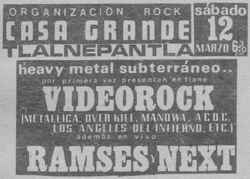 Since 1986 more and more concerts were organized, and in 1987 started the "Festival Metalero Azteca"
who was the first big Metal event with many of the most important bands of that time. Lazarov and the
other maker of the "HM Subterraneo" mag, organized Metal video shows followed by concerts, which
brought a big push into the scene. In 1988 the first international bands appeared. The very first were
3 hot Latina girls from the old province of Texas, with their band HEATHER LEATHER (they made a ultra
rare 7" single). They were followed by VICIOUS RUMORS; DEATH; ANGELES DEL INFIERNO and many more. 1988
was the ultimate festival year, with many of them and some followed every year. Against the still
existing violence and round-ups of the Police, and the everlasting threat of the close-down of the
"Chopo" market they organized demonstrations in several cities, which continued many years.
Since 1986 more and more concerts were organized, and in 1987 started the "Festival Metalero Azteca"
who was the first big Metal event with many of the most important bands of that time. Lazarov and the
other maker of the "HM Subterraneo" mag, organized Metal video shows followed by concerts, which
brought a big push into the scene. In 1988 the first international bands appeared. The very first were
3 hot Latina girls from the old province of Texas, with their band HEATHER LEATHER (they made a ultra
rare 7" single). They were followed by VICIOUS RUMORS; DEATH; ANGELES DEL INFIERNO and many more. 1988
was the ultimate festival year, with many of them and some followed every year. Against the still
existing violence and round-ups of the Police, and the everlasting threat of the close-down of the
"Chopo" market they organized demonstrations in several cities, which continued many years.
 Extreme fast Thrash Metal with brutal or accusing lyrics got more and more popular. This was played by
bands like TRANSMETAL; INQUISIDOR; NEXT; WRECKER and more.
But like in other countries there were also
this ugly Poser bands for many years, like MARA and VAGO. But different then in the rest of the world,
at the small festivals called "Chancoques", this kind of bands play together with extreme Thrash bands,
and even the fans come along with each other. Sometimes even normal Rock bands like EL TRI play
together with Thrash bands.
On the "Avanzada" label they even released exclusively some US bands. End of the 80s the labels "Denver"
and "Gas" started to release a lot of Metal. Almost all records of "Gas" are rare today, as they threw
away all the records which they did not sell! Beginning of the 90s came the first real big international
bands. Bad luck had the Spanish OBUS in 1990, as almost nobody came to their shows. This was because a
bigger international act was touring, ......the Pope! 1992 was a happy year for the Metal fans, as
TRANSMETAL got together again with their original singer, and LUZBEL united again too.
Extreme fast Thrash Metal with brutal or accusing lyrics got more and more popular. This was played by
bands like TRANSMETAL; INQUISIDOR; NEXT; WRECKER and more.
But like in other countries there were also
this ugly Poser bands for many years, like MARA and VAGO. But different then in the rest of the world,
at the small festivals called "Chancoques", this kind of bands play together with extreme Thrash bands,
and even the fans come along with each other. Sometimes even normal Rock bands like EL TRI play
together with Thrash bands.
On the "Avanzada" label they even released exclusively some US bands. End of the 80s the labels "Denver"
and "Gas" started to release a lot of Metal. Almost all records of "Gas" are rare today, as they threw
away all the records which they did not sell! Beginning of the 90s came the first real big international
bands. Bad luck had the Spanish OBUS in 1990, as almost nobody came to their shows. This was because a
bigger international act was touring, ......the Pope! 1992 was a happy year for the Metal fans, as
TRANSMETAL got together again with their original singer, and LUZBEL united again too.
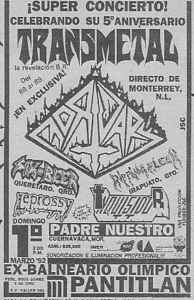 The extreme Metal got more and more popular. Death Metal bands realized, that lyrics and artwork from
the bloody Aztec and Maya times would fit ideal to their music. In the mid 80s the Latino Metal scene
growed together (through "MTV Latino"?). TRANSMETAL, who became end of the 80s the biggest Metal band in
the country, toured in other Latin American countries, and in US towns with high Latino population. In
1996 was the big "Festival Latinoamericano" with bands from Argentina (MALON), Chile (CRIMAINAL) and
more. In the same year was also the ultimate Mexican Metal festival for the 10 years celebration of
"Heavy Metal Subterraneo" fanzine, with 31 local bands!
The extreme Metal got more and more popular. Death Metal bands realized, that lyrics and artwork from
the bloody Aztec and Maya times would fit ideal to their music. In the mid 80s the Latino Metal scene
growed together (through "MTV Latino"?). TRANSMETAL, who became end of the 80s the biggest Metal band in
the country, toured in other Latin American countries, and in US towns with high Latino population. In
1996 was the big "Festival Latinoamericano" with bands from Argentina (MALON), Chile (CRIMAINAL) and
more. In the same year was also the ultimate Mexican Metal festival for the 10 years celebration of
"Heavy Metal Subterraneo" fanzine, with 31 local bands!
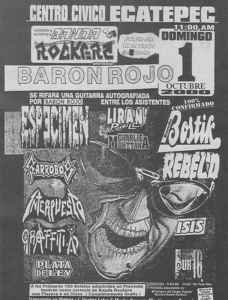 This all should not mislead you, because fact
is, that today the Mexican Metal scene consist mainly of Death and Black Metal bands. The old
still existing Thrash Metal acts became also much extremer and are almost like Death Metal
bands. Traditional Metal bands you had to search with a microscope at the middle and end of the
90s, but they still existed. LUZBEL exist still too, and plays the old style, but they don't
have the same status like in the 80s anymore. But another famous band became more or less
Mexican, ANGELES DEL INFIERNO moved to Mexico after some successful tours. They had two Mexican
members, but moved later to the US. Another band that was more active in Mexico was TERROR,
the band of Juan Garcia from AGENT STEEL. I must admit, that
some of the Death Metal bands from Mexico are really good, but I always hoped the True Metal
will become bigger again. Contrary to Argentina and Brazil it did not look very good, and you
had to be glad, if Metal survived in the underground. But since around the year 2000 it looks
better, and a lot of new bands appeared, like CALVARIA; SANTO OFICIO; PROYECTO MILENIO; EROGENA;
ANDARTA; ALIOTH; ARGOS and more. The older progressive band IRA became also a real
Power Metal band, and even the old CRYSTAL Y ACERO give full Power now.
There were also many re releases of old albums on CD, like from RAMSES; MEGATON; SIX BEER;
NEXT; KHAFRA and more!
This all should not mislead you, because fact
is, that today the Mexican Metal scene consist mainly of Death and Black Metal bands. The old
still existing Thrash Metal acts became also much extremer and are almost like Death Metal
bands. Traditional Metal bands you had to search with a microscope at the middle and end of the
90s, but they still existed. LUZBEL exist still too, and plays the old style, but they don't
have the same status like in the 80s anymore. But another famous band became more or less
Mexican, ANGELES DEL INFIERNO moved to Mexico after some successful tours. They had two Mexican
members, but moved later to the US. Another band that was more active in Mexico was TERROR,
the band of Juan Garcia from AGENT STEEL. I must admit, that
some of the Death Metal bands from Mexico are really good, but I always hoped the True Metal
will become bigger again. Contrary to Argentina and Brazil it did not look very good, and you
had to be glad, if Metal survived in the underground. But since around the year 2000 it looks
better, and a lot of new bands appeared, like CALVARIA; SANTO OFICIO; PROYECTO MILENIO; EROGENA;
ANDARTA; ALIOTH; ARGOS and more. The older progressive band IRA became also a real
Power Metal band, and even the old CRYSTAL Y ACERO give full Power now.
There were also many re releases of old albums on CD, like from RAMSES; MEGATON; SIX BEER;
NEXT; KHAFRA and more!
Meanwhile there devellope also other Metal centres besides Mexico City. Especially in the
North happens a lot, first of all in Monterrey. There were always Metal bands in this area
but there are many new bands in all directions. Since 2004 happens the "Monterrey Fest",
where already in the first time several Rock giants like TWISTED SISTER played. But it is also
a good audience for mexican bands. I received several mails from guys from the north
of Mexico, which complain, that I do not cover much bands from their area. Some of them were
real hate mails! I offered to pay for sending me this many material, ....but none of this
guys send me anything! Thanks for nothing to this guys!!
The trendy 90s Hardcore Metal got also some followers in Mexico, and True Metal fans should
be careful with bands like: LENGUAS MUERTAS; MALICIOUS PROPHECY; SEDICION; AKBAL; PARASITE;
DESARMADOR; BLASTER and many more, which are offered like regular Thrash. I hope to have covered
more or less all Hard Rock, Metal and Thrash bands with a vinyl or CD release.
METAL MEXICANO UN REPORTE DESDE EL PAÍS DE LOS TACOS, EL TEQUILA ... Y METALEROS.
Traduccion y algunas commentarios espciales, cortesia de Georgui Lazarov
<
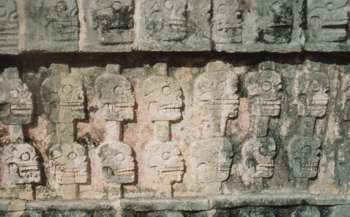 El país de México tiene mucho que ofrecer, desde los desiertos llenos de cáctus
en el norte hasta las selvas tropicales en el sur. En medio están
ubicadas las montañas de la Sierra Madre. Aún hoy en día es difícil viajar
en coche por las interminables curvas de las carreteras de este obstáculo
natural. Al visitante lo esperan no solamente una gran naturaleza, sino también
cientos de sitios históricos. Las ruinas mayas y los
aztecas son muy impresionantes. La comida picante y las bebidas alcohólicas
como el tequila y el mezcal (con el gusanito en la botella) son famosas. La
cerveza es muy buena, ¡mucho mejor que la de los anglo americanos!
La relación con sus vecinos del norte no es muy buena, lo cual no es de
extrañar ya que Estados Unidos se apropió de grandes territorios entre los
que se pueden mencionar Texas, Arizona, Nuevo México y California. ¡Nunca le
pregunten a un estadounidense acerca de viajar a México! Todos te
aconsejarían de no hacerlo ya que ellos le temen a ese país. La mayoría de
ellos conocen solamente los pueblos fronterizos los cuales son realmente
malos y llenos de ladrones y transas que tratan de estafar a los turistas.
Pero si viajas en el interior llegarás a conocer la verdadera vida y lo
amistosos que son los mexicanos, especialmente cuando se dan cuenta de que
no eres "gringo" de Estados Unidos. Así tendrás menos problemas.
La vida es la misma que en la mayoría de los países latinoamericanos. Por un
lado tienes una minoría de gente muy rica y por el otro a una mayoría de
gente muy pobre, con casi nada en el medio. La poca gente de piel clara son
en su mayoría de la clase acomodada y evita, rechaza y discrimina a los de
piel oscura, en su mayoría de origen indígena.
El país de México tiene mucho que ofrecer, desde los desiertos llenos de cáctus
en el norte hasta las selvas tropicales en el sur. En medio están
ubicadas las montañas de la Sierra Madre. Aún hoy en día es difícil viajar
en coche por las interminables curvas de las carreteras de este obstáculo
natural. Al visitante lo esperan no solamente una gran naturaleza, sino también
cientos de sitios históricos. Las ruinas mayas y los
aztecas son muy impresionantes. La comida picante y las bebidas alcohólicas
como el tequila y el mezcal (con el gusanito en la botella) son famosas. La
cerveza es muy buena, ¡mucho mejor que la de los anglo americanos!
La relación con sus vecinos del norte no es muy buena, lo cual no es de
extrañar ya que Estados Unidos se apropió de grandes territorios entre los
que se pueden mencionar Texas, Arizona, Nuevo México y California. ¡Nunca le
pregunten a un estadounidense acerca de viajar a México! Todos te
aconsejarían de no hacerlo ya que ellos le temen a ese país. La mayoría de
ellos conocen solamente los pueblos fronterizos los cuales son realmente
malos y llenos de ladrones y transas que tratan de estafar a los turistas.
Pero si viajas en el interior llegarás a conocer la verdadera vida y lo
amistosos que son los mexicanos, especialmente cuando se dan cuenta de que
no eres "gringo" de Estados Unidos. Así tendrás menos problemas.
La vida es la misma que en la mayoría de los países latinoamericanos. Por un
lado tienes una minoría de gente muy rica y por el otro a una mayoría de
gente muy pobre, con casi nada en el medio. La poca gente de piel clara son
en su mayoría de la clase acomodada y evita, rechaza y discrimina a los de
piel oscura, en su mayoría de origen indígena.
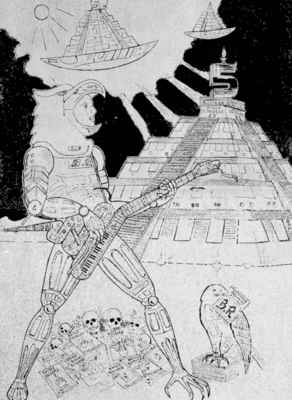 La ciudad de México es una metrópoli gigantesca, rodeada por altas montañas
como encerrada en un tazón con lo que la mayoría del año el smog permanece
encerrado ahí. La altitud es también muy elevada y debido a eso el aíre está
enrarecido por lo que las almas sensitivas deben evitarlo.
Esto también es una cazuela grande para fundir el Metal templado en todas sus
variaciones. Debido a los extremos problemas prevalecen la música y las
letras radicales. Los grupos cantan en inglés y en español y uno puede
encontrarse a más gente hablando inglés que en cualquier otro país
Latinoamericano.
La ciudad de México es una metrópoli gigantesca, rodeada por altas montañas
como encerrada en un tazón con lo que la mayoría del año el smog permanece
encerrado ahí. La altitud es también muy elevada y debido a eso el aíre está
enrarecido por lo que las almas sensitivas deben evitarlo.
Esto también es una cazuela grande para fundir el Metal templado en todas sus
variaciones. Debido a los extremos problemas prevalecen la música y las
letras radicales. Los grupos cantan en inglés y en español y uno puede
encontrarse a más gente hablando inglés que en cualquier otro país
Latinoamericano.
LA HISTORIA DEL ROCK
La historia de la música rock en México comenzó en la década de los 60s
principalmente con cantantes de música pop que hacían covers a prácticamente
todo el Top 40 de los Estados Unidos, que ni siquiera se molestaban en
traducir los textos de las canciones. Simplemente inventaban nuevas letras
en español para así poder llegar más fácilmente a las audiencias que en
aquel entonces casi no tenían conocimiento del idioma inglés y su cultura
era tan baja que muchas veces pensaban que los covers eran originales de
quien los cantaba que eran gente como ENRIQUE GUZMÁN, CÉSAR COSTA, JOHNNY
LABORIEL y otros por el estilo. Pero también había grupos dentro del mismo
método de hacer mercado y de ganarse la vida entre los que se pueden
mencionar a LOS BELMONTS, LOS HITTERS, LOS BOOPERS, LOS YAKIS, LOS ROCKING
DEVILS, LOS TEEN TOPS, LOS LOCOS DEL RITMO, LOS CAMISAS NEGRAS, LOS REBELDES
DEL ROCK y solistas como PACO CAÑEDO, RICARDO ROCA y el ex-Yakis, BENNY
IBARRA. Sin embargo, no fue hasta la segunda mitad de lesa década que los
verdaderos grupos de Rock mexicanos hicieron su aparición y comenzaron de la
misma manera: haciendo covers, pero en esta ocasión covers de grupos de Rock
norteamericanos e ingleses. También comenzaron a hacer su propio repertorio
cantado en español y de muy buena aceptación por parte de sus audiencias de
entusiasmados jóvenes.
Uno de los primeros grupos en ser reconocido y que destacó inclusive en
Estados Unidos, fue LA REVOLUCIÓN DE EMILIANO ZAPATA. Fue seguido por TONCHO
PILATOS (con las primeras letras de crítica contra el status quo), THREE
SOULS IN MY MIND (hoy en día EL TRI, una absoluta institución en el Rock
nacional) y muchos más.
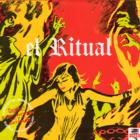
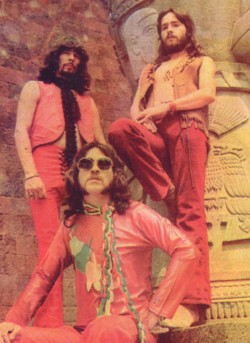 Los primeros grupos pesados aparecieron con bandas como EL RITUAL (su primer
disco de 1971 es un buen Hard Rock) y NÁHUATL (su primer álbum del '75 está
realmente bueno y para su tiempo absolutamente pesado, mientras que el
segundo es malo). Woodstock inspiró mucho a la escena mexicana y se organizó
uno mexicano, el Avándaro 1971 (con una audiencia de 150,000 personas). En
el escenario se produjo una agitación en contra de la miseria y el gobierno,
el cual solamente esperaba un motivo como este para iniciar, junto con los
medios de comunicación, una casería de brujas contra los "sucios,
drogadictos, comunistas y violentos" fans rockeros. Después de las masacres
de estudiantes previas a los juegos olímpicos del '68 (con cientos de
víctimas) el gobierno estaba de nueva cuenta persiguiendo a la juventud y su
nueva forma de expresión: la música Rock. Toda la escena fue reprimida y
suprimida, se prohibieron los conciertos, se cerraron los clubes, las
estaciones de radio fueron vetadas para los grupos de Rock, se censuraron
las publicaciones de Rock, se discriminaba a la gente con pelo largo o
vestimenta Hippie, etc. Esto realmente mató a la escena de por sí no muy
grande en esa época y muchos grupos desistieron, tronaron y desaparecieron.
Solamente aquellos que tenían cierto nivel económico lograron sobrevivir
hasta el final de los 70s como fue el caso del en aquel entonces solamente
THREE SOULS y algunos otros. El único lugar en la ciudad de México en el que
esporádicamente había eventos rockanroleros era el "Hip 70", local propiedad
del jóven empresario Armando Blanco, en el que la parte inferior era una
tienda de discos de Rock importados (en México prácticamente estaba vetada
la edición de discos de Rock extranjeros, no se hable de mexicanos) y en la
parte superior era un salón de eventos.
Otro grupo de esa época que tuvo gran influencia en la escena heavy fue
ENIGMA, quienes a finales de los 70s y principios de los 80s hicieron varios
discos de Hard Rock progresivo.
Los primeros grupos pesados aparecieron con bandas como EL RITUAL (su primer
disco de 1971 es un buen Hard Rock) y NÁHUATL (su primer álbum del '75 está
realmente bueno y para su tiempo absolutamente pesado, mientras que el
segundo es malo). Woodstock inspiró mucho a la escena mexicana y se organizó
uno mexicano, el Avándaro 1971 (con una audiencia de 150,000 personas). En
el escenario se produjo una agitación en contra de la miseria y el gobierno,
el cual solamente esperaba un motivo como este para iniciar, junto con los
medios de comunicación, una casería de brujas contra los "sucios,
drogadictos, comunistas y violentos" fans rockeros. Después de las masacres
de estudiantes previas a los juegos olímpicos del '68 (con cientos de
víctimas) el gobierno estaba de nueva cuenta persiguiendo a la juventud y su
nueva forma de expresión: la música Rock. Toda la escena fue reprimida y
suprimida, se prohibieron los conciertos, se cerraron los clubes, las
estaciones de radio fueron vetadas para los grupos de Rock, se censuraron
las publicaciones de Rock, se discriminaba a la gente con pelo largo o
vestimenta Hippie, etc. Esto realmente mató a la escena de por sí no muy
grande en esa época y muchos grupos desistieron, tronaron y desaparecieron.
Solamente aquellos que tenían cierto nivel económico lograron sobrevivir
hasta el final de los 70s como fue el caso del en aquel entonces solamente
THREE SOULS y algunos otros. El único lugar en la ciudad de México en el que
esporádicamente había eventos rockanroleros era el "Hip 70", local propiedad
del jóven empresario Armando Blanco, en el que la parte inferior era una
tienda de discos de Rock importados (en México prácticamente estaba vetada
la edición de discos de Rock extranjeros, no se hable de mexicanos) y en la
parte superior era un salón de eventos.
Otro grupo de esa época que tuvo gran influencia en la escena heavy fue
ENIGMA, quienes a finales de los 70s y principios de los 80s hicieron varios
discos de Hard Rock progresivo.
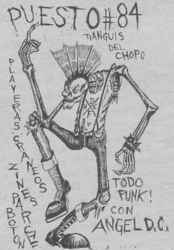 En 1980, frente a la puerta del Museo Cultural del Chopo en la ciudad de
México, en el cual frecuentemente había conciertos de Rock, se le ocurrió a
una persona práctica poner su cajita con discos LP y algunas otras
chucherías rockeras para vender a los que iban a las tocadas. De esta
manera, y con el tiempo, se convirtió en una costumbre que todos los sábados
se pusieran decenas de vendedores de todo tipo de mercancías relacionadas
con la música Rock ya fueran legales o piratas, pero para 1995 ya era un
tianguis rockero muy respetable en el cual se daban cita rockeros de todas
las corrientes musicales, músicos e integrantes de grupos, label managers de
independientes e inclusive grandes disqueras y todo tipo de personajes
ligados a la vida rockera. Debido a quejas de los vecinos del lugar el
Tianguis del Chopo fue peregrinando por varios lugares de la zona. Durante
el Mundial '86 lo ubicaron en la Ciudad Universitaria, para que finalmente y
desde hace 15 años se quedara en la calle de Oyamel entre Sol y Luna, cerca
de la terminal ferrocarrilera. Hoy en día ha perdido mucho de su atractivo y
esencia iniciales, pero sigue siendo un lugar interesante de reunión de
Rockeros, Punks, Heavies, Darkies, Góticos, etc., en el cual se puede
encontrar viejos LPs en vinil, independientes sin distribución, demos,
fanzines y parafernalia relacionada, especialmente la proliferación de la
piratería en todos los niveles.
En 1980, frente a la puerta del Museo Cultural del Chopo en la ciudad de
México, en el cual frecuentemente había conciertos de Rock, se le ocurrió a
una persona práctica poner su cajita con discos LP y algunas otras
chucherías rockeras para vender a los que iban a las tocadas. De esta
manera, y con el tiempo, se convirtió en una costumbre que todos los sábados
se pusieran decenas de vendedores de todo tipo de mercancías relacionadas
con la música Rock ya fueran legales o piratas, pero para 1995 ya era un
tianguis rockero muy respetable en el cual se daban cita rockeros de todas
las corrientes musicales, músicos e integrantes de grupos, label managers de
independientes e inclusive grandes disqueras y todo tipo de personajes
ligados a la vida rockera. Debido a quejas de los vecinos del lugar el
Tianguis del Chopo fue peregrinando por varios lugares de la zona. Durante
el Mundial '86 lo ubicaron en la Ciudad Universitaria, para que finalmente y
desde hace 15 años se quedara en la calle de Oyamel entre Sol y Luna, cerca
de la terminal ferrocarrilera. Hoy en día ha perdido mucho de su atractivo y
esencia iniciales, pero sigue siendo un lugar interesante de reunión de
Rockeros, Punks, Heavies, Darkies, Góticos, etc., en el cual se puede
encontrar viejos LPs en vinil, independientes sin distribución, demos,
fanzines y parafernalia relacionada, especialmente la proliferación de la
piratería en todos los niveles.
LA HISTORIA DEL METAL
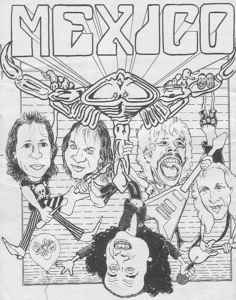 A principios de la década de los 80s también llegó a México la "Nueva Ola del
Heavy Metal Británico" (NWOBHM). Los grupos que más influenciaron la escena
nacional fueron grupos como IRON MAIDEN, DEF LEPPARD, TYGERS OF PAN TANG,
mientras que los alemanes de SCORPIONS no se quedaron atrás con su
"Blackout". Lo más curioso y al mismo tiempo lógico, fue que el brote de la
nueva generación de grupos pesados se dio primero en las ciudades
fronterizas con Estados Unidos donde las novedades llegaban más rápido,
había manera de brincar al otro lado para ver a las nuevas bandas y la
influencia era más directa. Tal era el caso de bandas como DEATH WARRANT de
Ciudad Juárez y CRAZY LAZY de Monterrey, quienes fueron uno de los primeros
grupos en editar su propio álbum.
En la ciudad de México no fue hasta mediados de la década de los 80s que
repentinamente aparecieron en la escena subterránea decenas de grupos de
Heavy Metal vestidos de cuero negro, cadenas y estoperoles. Si inicialmente
todos pasaban por el bautizo forzoso de tocar covers, con el tiempo seguían
con su material propio. A veces con y a veces sin éxito. La escena se fue
desarrollando, los fans crecían, no aceptaban nada que no fuera Metal. El
Metal era lo bueno y los demás eran Posers. Actitud errónea que a la larga
los convirtió a ellos mismos en unos Posers.
El Heavy Metal melódico británico rápidamente fue sustituido por dos nuevas
corrientes provenientes de Estados Unidos, Europa y Japón: una de Metal
comercial y otro de metal proveniente de las independientes como "Metal Blade
Records" y "Combat Rocords". El primero, con exponentes como MOTLEY CRUE, RATT,
TWISTED SISTER, DOKKEN, los europeos de HELLOWEEN, ACCEPT y los japoneses de
LOUDNESS, iniciaron la moda de los trapitos de color, reflejada rápidamente
en los grupos de Rock mexicanos quienes optaron por cambiar de vestuario.
Los que no lo hicieron fueron aquellos que quedaron fascinados con el nuevo
género, la segunda corriente, que aportaban grupos como SLAYER, MEGADETH,
METALLICA y los europeos de VENOM (Inglaterra), MERCYFUL FATE (Dinamarca),
BULLDOZER (Italia), por mencionar algunos.
A principios de la década de los 80s también llegó a México la "Nueva Ola del
Heavy Metal Británico" (NWOBHM). Los grupos que más influenciaron la escena
nacional fueron grupos como IRON MAIDEN, DEF LEPPARD, TYGERS OF PAN TANG,
mientras que los alemanes de SCORPIONS no se quedaron atrás con su
"Blackout". Lo más curioso y al mismo tiempo lógico, fue que el brote de la
nueva generación de grupos pesados se dio primero en las ciudades
fronterizas con Estados Unidos donde las novedades llegaban más rápido,
había manera de brincar al otro lado para ver a las nuevas bandas y la
influencia era más directa. Tal era el caso de bandas como DEATH WARRANT de
Ciudad Juárez y CRAZY LAZY de Monterrey, quienes fueron uno de los primeros
grupos en editar su propio álbum.
En la ciudad de México no fue hasta mediados de la década de los 80s que
repentinamente aparecieron en la escena subterránea decenas de grupos de
Heavy Metal vestidos de cuero negro, cadenas y estoperoles. Si inicialmente
todos pasaban por el bautizo forzoso de tocar covers, con el tiempo seguían
con su material propio. A veces con y a veces sin éxito. La escena se fue
desarrollando, los fans crecían, no aceptaban nada que no fuera Metal. El
Metal era lo bueno y los demás eran Posers. Actitud errónea que a la larga
los convirtió a ellos mismos en unos Posers.
El Heavy Metal melódico británico rápidamente fue sustituido por dos nuevas
corrientes provenientes de Estados Unidos, Europa y Japón: una de Metal
comercial y otro de metal proveniente de las independientes como "Metal Blade
Records" y "Combat Rocords". El primero, con exponentes como MOTLEY CRUE, RATT,
TWISTED SISTER, DOKKEN, los europeos de HELLOWEEN, ACCEPT y los japoneses de
LOUDNESS, iniciaron la moda de los trapitos de color, reflejada rápidamente
en los grupos de Rock mexicanos quienes optaron por cambiar de vestuario.
Los que no lo hicieron fueron aquellos que quedaron fascinados con el nuevo
género, la segunda corriente, que aportaban grupos como SLAYER, MEGADETH,
METALLICA y los europeos de VENOM (Inglaterra), MERCYFUL FATE (Dinamarca),
BULLDOZER (Italia), por mencionar algunos.
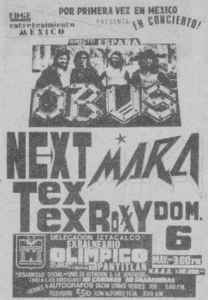 Como paréntesis se puede mencionar la aparición de un peculiar y particular
mosh, slam y stage dive mexicanos que se escenificaban en los conciertos,
especialmente el slam dance: en medio del público parado se quedaba un
centro nutrido de gente que levantaba los puños al ritmo de la música,
chiflaba y gritaba, mientras que en su alrededor se formaba un violento y
arrasador círculo viviente compuesto de extasiados y eufóricos fans que
brincaban y corrían como animales desenfrenados. La escena, que sigue
practicándose inclusive hoy en día, recuerda mucho a los viejos bailes
indios siendo mucho menos violenta que los "pits" que se arman en Estados
Unidos y Europa. Inclusive se pueden ver muchas chavas (muchachas) en el
slam dance. Unicos son también los "Hermanos metaleros" ya que en muchas
bandas hay dos o tres hermanos, lo cual no es raro, inclusive SIX BEERS
llegó a tener 4 hermanos en sus filas.
En aquella época muchos grupos usaban maquillaje y vestimenta estrafalaria.
Inicialmente todos cantaban su material en español, pero con el tiempo y
buscando salirse del mercado nacional, se dieron cuenta de que había que
cantar en inglés, igual que lo hacían muchos grupos de todo el mundo que
buscaban entrar al mercado norteamericano.
Las primeras compañías independientes aparecieron como resultado de la
necesidad de material grabado que pedían los fans ya que las trasnacionales,
ignorando por completo los grupos extranjeros, ni cuenta se daban de la
existencia de los nacionales.
Como paréntesis se puede mencionar la aparición de un peculiar y particular
mosh, slam y stage dive mexicanos que se escenificaban en los conciertos,
especialmente el slam dance: en medio del público parado se quedaba un
centro nutrido de gente que levantaba los puños al ritmo de la música,
chiflaba y gritaba, mientras que en su alrededor se formaba un violento y
arrasador círculo viviente compuesto de extasiados y eufóricos fans que
brincaban y corrían como animales desenfrenados. La escena, que sigue
practicándose inclusive hoy en día, recuerda mucho a los viejos bailes
indios siendo mucho menos violenta que los "pits" que se arman en Estados
Unidos y Europa. Inclusive se pueden ver muchas chavas (muchachas) en el
slam dance. Unicos son también los "Hermanos metaleros" ya que en muchas
bandas hay dos o tres hermanos, lo cual no es raro, inclusive SIX BEERS
llegó a tener 4 hermanos en sus filas.
En aquella época muchos grupos usaban maquillaje y vestimenta estrafalaria.
Inicialmente todos cantaban su material en español, pero con el tiempo y
buscando salirse del mercado nacional, se dieron cuenta de que había que
cantar en inglés, igual que lo hacían muchos grupos de todo el mundo que
buscaban entrar al mercado norteamericano.
Las primeras compañías independientes aparecieron como resultado de la
necesidad de material grabado que pedían los fans ya que las trasnacionales,
ignorando por completo los grupos extranjeros, ni cuenta se daban de la
existencia de los nacionales.
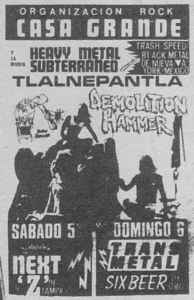 La compañía "Comrock" fue la primera en firmar a grupos como LUZBEL y RAMSES,
pero quebró rápidamente debido a la inexperiencia de sus fundadores. Nunca
pones oficinas con decenas de máquinas de escribir, secretarias, label
managers y directores si no tienes contrato de distribución con una
trasnacional, si no hay lugares donde toquen tus grupos, no hay festivales,
si la radio no toca este material, y miles de etcéteras. "Comrock" fue con
"Warner Music" (WEA en aquel entonces) en busca de contrato de distribución.
Se lo dieron y debido a la inexperiencia de "Comrock" les dieron falsos datos
sobre ventas, señalando bajas ventas y finalmente compraron a "Comrock". Se
quedaron con los grupos que les interesaban y los demás los mandaron a
volar. De nueva cuenta estaba el factor inexperiencia: la trasnacional no
sabía cómo manejar grupos de Rock mexicanos. Pensaban que podían tratarlos
como otro tipo de artistas, les editaron discos más grabados y producidos y
muy pronto tuvieron que despedir a los grupos. Pero de cómo funcionaban las
trasnacionales con sus label managers en aquel entonces no tiene ninguna
diferencia de cómo funcionan hoy en día, pero esto es otro cuento.
Definitivamente todo estaba desorganizado. No había managers, no había
empresarios de conciertos de Rock, no había compañías de discos
independientes estables, no había lugares para conciertos, pero había muchas
ganas, amor por la música y muchos fans.
La compañía "Comrock" fue la primera en firmar a grupos como LUZBEL y RAMSES,
pero quebró rápidamente debido a la inexperiencia de sus fundadores. Nunca
pones oficinas con decenas de máquinas de escribir, secretarias, label
managers y directores si no tienes contrato de distribución con una
trasnacional, si no hay lugares donde toquen tus grupos, no hay festivales,
si la radio no toca este material, y miles de etcéteras. "Comrock" fue con
"Warner Music" (WEA en aquel entonces) en busca de contrato de distribución.
Se lo dieron y debido a la inexperiencia de "Comrock" les dieron falsos datos
sobre ventas, señalando bajas ventas y finalmente compraron a "Comrock". Se
quedaron con los grupos que les interesaban y los demás los mandaron a
volar. De nueva cuenta estaba el factor inexperiencia: la trasnacional no
sabía cómo manejar grupos de Rock mexicanos. Pensaban que podían tratarlos
como otro tipo de artistas, les editaron discos más grabados y producidos y
muy pronto tuvieron que despedir a los grupos. Pero de cómo funcionaban las
trasnacionales con sus label managers en aquel entonces no tiene ninguna
diferencia de cómo funcionan hoy en día, pero esto es otro cuento.
Definitivamente todo estaba desorganizado. No había managers, no había
empresarios de conciertos de Rock, no había compañías de discos
independientes estables, no había lugares para conciertos, pero había muchas
ganas, amor por la música y muchos fans.
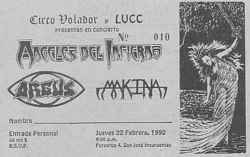 De esta manera se juntaron varias
personas para formar una organización que orientara y ayudara a los grupos
para que grabaran su material y tuvieran espacios donde presentarlo en vivo.
Una especie de compañía de manejo y sello disquero al mismo tiempo. Los que
arriesgaron en este proyecto provenían de varios medios: Gustavo Solis,
Arturo Huizar y Daniel Ojeda provenían de grupos de Rock, RAMSES, LUZBEL y
CARONTE respectivamente, Carlo F. Hernández y Gueorgui Lazarov de los medios
informativos, Omar Escalante y Alejandro Mendoza eran simples fans del
Metal. De esta manera nació en 1986 el llamado "Escuadrón Metálico" cuyos
primeros protegidos aparecieron en el acoplado "Proyecto I" que fue editado
bajo el sello "Rosenbach", (propiedad del grupo progresivo ICONOCLAST, cuyo
baterista, Victor Baldovinos se convirtió en una especie de productor
oficial y parte integrante de la organización), ya que el "Escuadrón" no
estaba de alto como casa editora de discos. Otros de los grupos que se
fueron adheriendo a la organizaciòn fueron gente como ULTIMATUM,
APOCALIPSIS, MEGATON, DEATH WARRANT, VIRGIN WITCH, SUPER ALFA, ABBADON,
ALUCARD, AUSTER, ASPID y varios más.
De esta manera se juntaron varias
personas para formar una organización que orientara y ayudara a los grupos
para que grabaran su material y tuvieran espacios donde presentarlo en vivo.
Una especie de compañía de manejo y sello disquero al mismo tiempo. Los que
arriesgaron en este proyecto provenían de varios medios: Gustavo Solis,
Arturo Huizar y Daniel Ojeda provenían de grupos de Rock, RAMSES, LUZBEL y
CARONTE respectivamente, Carlo F. Hernández y Gueorgui Lazarov de los medios
informativos, Omar Escalante y Alejandro Mendoza eran simples fans del
Metal. De esta manera nació en 1986 el llamado "Escuadrón Metálico" cuyos
primeros protegidos aparecieron en el acoplado "Proyecto I" que fue editado
bajo el sello "Rosenbach", (propiedad del grupo progresivo ICONOCLAST, cuyo
baterista, Victor Baldovinos se convirtió en una especie de productor
oficial y parte integrante de la organización), ya que el "Escuadrón" no
estaba de alto como casa editora de discos. Otros de los grupos que se
fueron adheriendo a la organizaciòn fueron gente como ULTIMATUM,
APOCALIPSIS, MEGATON, DEATH WARRANT, VIRGIN WITCH, SUPER ALFA, ABBADON,
ALUCARD, AUSTER, ASPID y varios más.
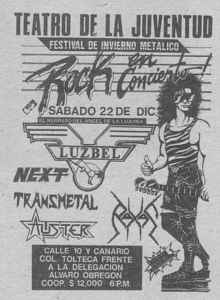 Entre los grupos que aparecieron en el
primer disco acoplado estaban Z, KHAFRA y GEHENNA de los cuales
posteriormente se editaron discos completos. Paulatinamente el Escuadrón
Metálico llegó a transformarse y finalmente se quedó solo como sello
disquero en el cual figuraban como socios Omar Escalante, Alejandro "EL
Dock" Mendoza, Gueorgui Lazarov, Daniel Ojeda y Gustavo Solis, este último
no tardó en pedir que se le liquidaran sus acciones debido a problemas
personales. Sabia decisión en ese momento como se verá más adelante. Par de
años después Daniel Ojeda también decidió por retirarse de la compañía
quedándose Lazarov a cargo de las ediciones internacionales, diseño gráfico
de las portadas, ventas y distribución local y por correo, Mendoza de las
ediciones nacionales y Escalante como gerente general de la compañía.
Siguieron dos acoplados más, varias ediciones de grupos nacionales y las
actividades de promoción se vincularon estrechamente con las actividades que
desarrollaba la revista "Heavy Metal Subterráneo". Esta fue realmente la
primera revista subterránea en México dedicada 100% al Metal y al Rock. Fue
una idea de Carlo F. Hernández, quien a finales de 1985 le comentó a otro
colaborador de la revista "Conecte", Gueorgui Lazarov, la viabilidad de hacer
una nueva revista pero inicialmente como suplemento de "Conecte". Ambos eran
amantes del Metal, Carlo tenía las ideas, Lazarov tenía el material, y ambos
se llevaban muy bien con el editor de "Conecte", el Sr. Arnulfo Flores.
Después de insistir un buen rato y vender bien el proyecto, la revista
"Conecte" editó en febrero de 1986 el primer número especial de "Heavy Metal
Subterráneo" como un complemento de la revista "Conecte".
Entre los grupos que aparecieron en el
primer disco acoplado estaban Z, KHAFRA y GEHENNA de los cuales
posteriormente se editaron discos completos. Paulatinamente el Escuadrón
Metálico llegó a transformarse y finalmente se quedó solo como sello
disquero en el cual figuraban como socios Omar Escalante, Alejandro "EL
Dock" Mendoza, Gueorgui Lazarov, Daniel Ojeda y Gustavo Solis, este último
no tardó en pedir que se le liquidaran sus acciones debido a problemas
personales. Sabia decisión en ese momento como se verá más adelante. Par de
años después Daniel Ojeda también decidió por retirarse de la compañía
quedándose Lazarov a cargo de las ediciones internacionales, diseño gráfico
de las portadas, ventas y distribución local y por correo, Mendoza de las
ediciones nacionales y Escalante como gerente general de la compañía.
Siguieron dos acoplados más, varias ediciones de grupos nacionales y las
actividades de promoción se vincularon estrechamente con las actividades que
desarrollaba la revista "Heavy Metal Subterráneo". Esta fue realmente la
primera revista subterránea en México dedicada 100% al Metal y al Rock. Fue
una idea de Carlo F. Hernández, quien a finales de 1985 le comentó a otro
colaborador de la revista "Conecte", Gueorgui Lazarov, la viabilidad de hacer
una nueva revista pero inicialmente como suplemento de "Conecte". Ambos eran
amantes del Metal, Carlo tenía las ideas, Lazarov tenía el material, y ambos
se llevaban muy bien con el editor de "Conecte", el Sr. Arnulfo Flores.
Después de insistir un buen rato y vender bien el proyecto, la revista
"Conecte" editó en febrero de 1986 el primer número especial de "Heavy Metal
Subterráneo" como un complemento de la revista "Conecte".
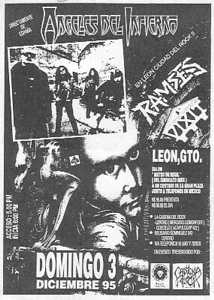 El Metal se estaba
haciendo muy popular, pero el formato y la dirección de Conecte no permitían
mucho de Metal.
Debido a la buena respuesta de los lectores y a pesar de las
bajas ventas iniciales, se editó un segundo número especial y al mantenerse
las ventas estables siguieron otros dos número, pero la "Heavy Metal
Subterráneo" como una nueva revista. A la par de la revista, a Carlo se le
ocurrió la idea de organizar eventos de Metal en los cuales se proyectaran
videos de Metal (casi imposibles de conseguir en México en aquel entonces ya
que los tenían solamente aquellos que tenían parabólica) y se presentaran
grupos nacionales de Metal. Fue en ese momento en que cuajó mejor la
relación entre el "Escuadrón Metálico" y la revista.
El Metal se estaba
haciendo muy popular, pero el formato y la dirección de Conecte no permitían
mucho de Metal.
Debido a la buena respuesta de los lectores y a pesar de las
bajas ventas iniciales, se editó un segundo número especial y al mantenerse
las ventas estables siguieron otros dos número, pero la "Heavy Metal
Subterráneo" como una nueva revista. A la par de la revista, a Carlo se le
ocurrió la idea de organizar eventos de Metal en los cuales se proyectaran
videos de Metal (casi imposibles de conseguir en México en aquel entonces ya
que los tenían solamente aquellos que tenían parabólica) y se presentaran
grupos nacionales de Metal. Fue en ese momento en que cuajó mejor la
relación entre el "Escuadrón Metálico" y la revista.
Para junio de 1986 salía el #5 de "Heavy Metal Subterráneo", pero de manera
totalmente independiente de "Conecte" y su editora ya que debido a grillas
internas el editor decidió suspender su publicación, pero accedió que sus
creadores y dueños de su nombre la siguieran editando de manera
independiente. Con el éxito de los eventos de videos y grupos nacionales se
logró juntar dinero y nuevamente Carlo salió con una buena idea: traer a
grupos americanos de Metal. Para eso hacía falta un local mayor, permisos y
equipo de audio más grande con lo que se contactó al Sr. Héctor Guzman quien
llevaba algún tiempo haciendo eventos musicales en la "Arena Lopez Mateos" y
tenía su propia organización llamada "Casagrande". Otra gran palanca de ayuda
en todo esto lo fue el programa Heavy Metal que Gueorgui Lazarov conducía en
la ahora extinta estación de radio "Rock 101". en ese programa se tocaba todo
lo que se podía leer en la revista y posteriormente se entrevistaban a todos
los grupos que traía la revista a conciertos en México.
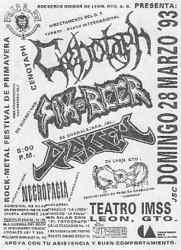 Para 1987 se traía un primer grupo, HEATHER LEATHER, un trío de chavas de
Texas que tocaba más Hard Rock que Heavy Metal, pero que habían editado un
sencillo de 7 pulgadas y eran más o menos conocidas en México.
Posteriormente siguieron grupos como DEMOLITION HAMMER, VICIOUS RUMORS,
DEATH, ANGELES DEL INFIERNO etc. Inclusive se empezó a incursionar con los
grupos en provincia como fue el caso de DEVASTACION en Querétaro. A la par
de todo esto el movimiento metalero estaba tomando rápidamente auge en
México, aumentaba y evolucionaba. Grupos de Thrash Metal con letras
acusadoras y extremas se hicieron cada vez más populares. Este tipo de
música estaba siendo tocado por grupos como TRANSMETAL, NEXT, INQUISIDOR,
WRECKER y otros más. Lo más curioso es que en México, a diferencia de
Estados Unidos los grupos de las diferentes corrientes musicales nunca
fueron enemigos y siempre compartían un escenario en los llamados
"chancoques" con tal de poder tocar en vivo y ganar algo de dinero para
sobrevivir. No era raro ver compartir escenario a los grupos mencionados
arriba con grupos como MARA y VAGO y hasta con el TRI.
Mientras tanto "Avanzada Metálica" ya estaba editando también grupos
americanos y europeos de Metal bajo licencia, inclusive algunos brasileños.
A la fiebre metalera se unieron otros dos sellos independientes, "Gas" y
"Denver", la cual a la postre se quedaría con casi todo el catálogo de
"Avanzada Metálica".
Los discos chapopote de estas compañías son un artículo
raro el día de hoy y muy valioso para los coleccionistas ya que con los CDs
la gente dejó de comprar chapopote y las disqueras simplemente tiraron a la
basura el material en vinil que ocupa mucho más espacio en los almacenes que
el CD.
Para 1987 se traía un primer grupo, HEATHER LEATHER, un trío de chavas de
Texas que tocaba más Hard Rock que Heavy Metal, pero que habían editado un
sencillo de 7 pulgadas y eran más o menos conocidas en México.
Posteriormente siguieron grupos como DEMOLITION HAMMER, VICIOUS RUMORS,
DEATH, ANGELES DEL INFIERNO etc. Inclusive se empezó a incursionar con los
grupos en provincia como fue el caso de DEVASTACION en Querétaro. A la par
de todo esto el movimiento metalero estaba tomando rápidamente auge en
México, aumentaba y evolucionaba. Grupos de Thrash Metal con letras
acusadoras y extremas se hicieron cada vez más populares. Este tipo de
música estaba siendo tocado por grupos como TRANSMETAL, NEXT, INQUISIDOR,
WRECKER y otros más. Lo más curioso es que en México, a diferencia de
Estados Unidos los grupos de las diferentes corrientes musicales nunca
fueron enemigos y siempre compartían un escenario en los llamados
"chancoques" con tal de poder tocar en vivo y ganar algo de dinero para
sobrevivir. No era raro ver compartir escenario a los grupos mencionados
arriba con grupos como MARA y VAGO y hasta con el TRI.
Mientras tanto "Avanzada Metálica" ya estaba editando también grupos
americanos y europeos de Metal bajo licencia, inclusive algunos brasileños.
A la fiebre metalera se unieron otros dos sellos independientes, "Gas" y
"Denver", la cual a la postre se quedaría con casi todo el catálogo de
"Avanzada Metálica".
Los discos chapopote de estas compañías son un artículo
raro el día de hoy y muy valioso para los coleccionistas ya que con los CDs
la gente dejó de comprar chapopote y las disqueras simplemente tiraron a la
basura el material en vinil que ocupa mucho más espacio en los almacenes que
el CD.
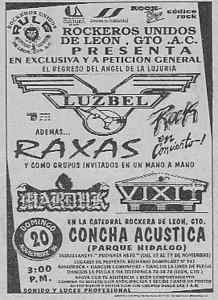 Los inicios de la década de los '90 prometía mucho para la serie de
conciertos que organizaba la revista "Heavy Metal Subterráneo" junto con
"Casagrande". En Febrero de ese año ANGELES DEL INFIERNO barrió con todas las
expectativas de asistencia llenado todos los conciertos. Para el mes de mayo
el grupo español OBUS no logró ni para cubrir gastos ya que contaba con una
mayor competencia en cuanto a show se refiere ... el Papa estaba de gira por
México.
El año de 1992 fue uno feliz para los fans del Metal ya que regresó a
TRANSMETAL su vocalista original y LUZBEL se reunificó.
El Metal extremo seguía haciéndose cada vez más popular. Los grupos de Death
Metal se percataron de que las letras y el arte de las épocas sangrientas de
los Mexicas y el esplendor arquitectónico de los Mayas serían ideales para
su música. El canal de MTV y VH1 hicieron aparición en la nueva cadena
televisiva MVS y la gente comenzó a enterarse mucho más sobre el Metal
especialmente a través del ahora difunto "Headbanger's Ball". Posteriormente
apareció el "MTV Latino" que inicialmente prometía mucho ya que en el ya
mencionado programa comenzaron a aparecer los primeros y primitivos videos
de los grupos metaleros mexicanos. A los pocos años desapareció el
"Headbanger's Ball" y "MTV Latino" chafeó olímpicamente por lo que la gente en
la actualidad está regresando a los impresos y a incursionar en el Internet
en busca de noticias e información metalera.
TRANSMETAL fue uno de los primeros grupos metaleros en ir de gira por
América Latina e incluso Estados Unidos convirtiéndose en el máximo
exponente del Metal mexicano.
Otra de las características de los noventas en el Metal mexicano fue la
rápida transición del Metal mexicano hacia nuevas formas, géneros y
corrientes. El Grunge, el Garage estaban de moda, el Hardcore estaba
influenciando, el Black y el Death Metal evolucionaron hacia nuevas formas
de expresión al igual que los vestuarios, el Metal melódico y los músicos
bonitos, rubios, vestidos de trapitos de colores dieron paso a los Dark, a
los Góticos, los estoperoles y cadenas dieron paso a mantas negras y largas,
capuchas y demás parafernalia demoníaca.
Los inicios de la década de los '90 prometía mucho para la serie de
conciertos que organizaba la revista "Heavy Metal Subterráneo" junto con
"Casagrande". En Febrero de ese año ANGELES DEL INFIERNO barrió con todas las
expectativas de asistencia llenado todos los conciertos. Para el mes de mayo
el grupo español OBUS no logró ni para cubrir gastos ya que contaba con una
mayor competencia en cuanto a show se refiere ... el Papa estaba de gira por
México.
El año de 1992 fue uno feliz para los fans del Metal ya que regresó a
TRANSMETAL su vocalista original y LUZBEL se reunificó.
El Metal extremo seguía haciéndose cada vez más popular. Los grupos de Death
Metal se percataron de que las letras y el arte de las épocas sangrientas de
los Mexicas y el esplendor arquitectónico de los Mayas serían ideales para
su música. El canal de MTV y VH1 hicieron aparición en la nueva cadena
televisiva MVS y la gente comenzó a enterarse mucho más sobre el Metal
especialmente a través del ahora difunto "Headbanger's Ball". Posteriormente
apareció el "MTV Latino" que inicialmente prometía mucho ya que en el ya
mencionado programa comenzaron a aparecer los primeros y primitivos videos
de los grupos metaleros mexicanos. A los pocos años desapareció el
"Headbanger's Ball" y "MTV Latino" chafeó olímpicamente por lo que la gente en
la actualidad está regresando a los impresos y a incursionar en el Internet
en busca de noticias e información metalera.
TRANSMETAL fue uno de los primeros grupos metaleros en ir de gira por
América Latina e incluso Estados Unidos convirtiéndose en el máximo
exponente del Metal mexicano.
Otra de las características de los noventas en el Metal mexicano fue la
rápida transición del Metal mexicano hacia nuevas formas, géneros y
corrientes. El Grunge, el Garage estaban de moda, el Hardcore estaba
influenciando, el Black y el Death Metal evolucionaron hacia nuevas formas
de expresión al igual que los vestuarios, el Metal melódico y los músicos
bonitos, rubios, vestidos de trapitos de colores dieron paso a los Dark, a
los Góticos, los estoperoles y cadenas dieron paso a mantas negras y largas,
capuchas y demás parafernalia demoníaca.
 El Metal entraba a una nueva fase.
Sin embargo, seguía habiendo Metal tradicional y eso se vio claramente en el
"Festival Latinoamericano" celebrado en 1996 con la presencia de grupos como
MALON (Argentina) y CRIMINAL (Chile) y muchos más. Ese mismo año se celebró
el festival más grande de Metal mexicano al celebrarse el décimo aniversario
de la revista "Heavy Metal Subterráneo" con la participación de 31 bandas
locales.
El Metal entraba a una nueva fase.
Sin embargo, seguía habiendo Metal tradicional y eso se vio claramente en el
"Festival Latinoamericano" celebrado en 1996 con la presencia de grupos como
MALON (Argentina) y CRIMINAL (Chile) y muchos más. Ese mismo año se celebró
el festival más grande de Metal mexicano al celebrarse el décimo aniversario
de la revista "Heavy Metal Subterráneo" con la participación de 31 bandas
locales.
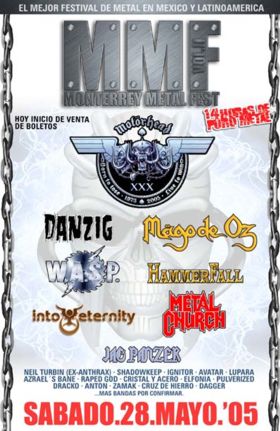 Esto no debe llevar a una conclusión errónea ya que el Metal
mexicano consiste hoy en día principalmente de grupos de Black y Death
Metal, pero también destacan bandas alternativas como RESORTE que le dan un
nuevo aíre, pero eso es otro cuento.
Los todavía existentes grupos de Thrash también han optado por tocar de
manera más extrema y se acercan al Death Metal, pero los tradicionales hay
que buscarlos con lupa y el que parece haberse estancado en su ya "propio"
estilo son los del TRANSMETAL. A pesar del gran regreso de LUZBEL su
material no aporta nada nuevo, sigue la misma línea que les dio éxito en los
'80, las composiciones no tienen inspiración y no le llegan a la nueva
generación de metaleros. Curiosamente, un grupo que no es mexicano, pero que
ha tenido giras muy exitosas por México, ANGELES DEL INFIERNO, se ha mudado
a este país y tiene dos miembros mexicanos, pero viven ahora en USA.
Otro grupo bien activo en México fue TERROR, el grupo del ex integrante de
AGENT STEEL, Juan García.
Ahora, si bien es cierto que un buen de grupos mexicanos de Death y Black
son excelentes, se espera un gran regreso del Heavy Metal tradicional.
Contrariamente a Argentina y Brazil, las cosas no fueron muy alentadoras,
pero el regreso será grande por lo menos en el underground.
El trendy Hardcore Metal de los '90 también tiene seguidores en México y no
hay que confiar mucho en bandas como LENGUAS MUERTAS, MALICIOUS PROPHECIES,
SEDICION, AKBAL, PARASITE, DESARMADOR, BLASTER y muchos más.
Esto no debe llevar a una conclusión errónea ya que el Metal
mexicano consiste hoy en día principalmente de grupos de Black y Death
Metal, pero también destacan bandas alternativas como RESORTE que le dan un
nuevo aíre, pero eso es otro cuento.
Los todavía existentes grupos de Thrash también han optado por tocar de
manera más extrema y se acercan al Death Metal, pero los tradicionales hay
que buscarlos con lupa y el que parece haberse estancado en su ya "propio"
estilo son los del TRANSMETAL. A pesar del gran regreso de LUZBEL su
material no aporta nada nuevo, sigue la misma línea que les dio éxito en los
'80, las composiciones no tienen inspiración y no le llegan a la nueva
generación de metaleros. Curiosamente, un grupo que no es mexicano, pero que
ha tenido giras muy exitosas por México, ANGELES DEL INFIERNO, se ha mudado
a este país y tiene dos miembros mexicanos, pero viven ahora en USA.
Otro grupo bien activo en México fue TERROR, el grupo del ex integrante de
AGENT STEEL, Juan García.
Ahora, si bien es cierto que un buen de grupos mexicanos de Death y Black
son excelentes, se espera un gran regreso del Heavy Metal tradicional.
Contrariamente a Argentina y Brazil, las cosas no fueron muy alentadoras,
pero el regreso será grande por lo menos en el underground.
El trendy Hardcore Metal de los '90 también tiene seguidores en México y no
hay que confiar mucho en bandas como LENGUAS MUERTAS, MALICIOUS PROPHECIES,
SEDICION, AKBAL, PARASITE, DESARMADOR, BLASTER y muchos más.
------------------------------------------------------------------------------
Version Espanol en construccion!
But since around the year 2000 it looks
better, and a lot of new bands appeared, like CALVARIA; SANTO OFICIO; PROYECTO MILENIO; EROGENA;
ANDARTA; ALIOTH; ARGOS and more. The older progressive band IRA became also a real
Power Metal band, and even the old CRYSTAL Y ACERO give full Power now.
There were also many re releases of old albums on CD, like from RAMSES; MEGATON; SIX BEER;
NEXT; KHAFRA and more!
Meanwhile there devellope also other Metal centres besides Mexico City. Especially in the
North happens a lot, first of all in Monterrey. There were always Metal bands in this area
but there are many new bands in all directions. Since 2004 happens the "Monterrey Fest",
where already in the first time several Rock giants like TWISTED SISTER played. But it is also
a good audience for mexican bands. I received several mails from guys from the north
of Mexico, which complain, that I do not cover much bands from their area. Some of them were
real hate mails! I offered to pay for sending me this many material, ....but none of this
guys send me anything! Thanks for nothing to this guys!!
----------------------------------------------------------------------------------
De esta manera espero haber cubierto más o menos a los grupos de Hard Rock,
Metal y Thrash que hayan editado en vinil y en CD.
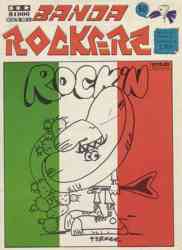
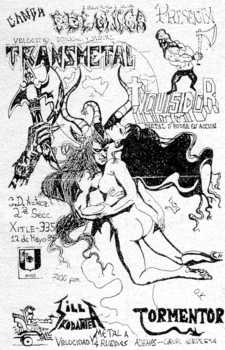 Un acontecimiento importante en la escena mexicana fue el cierre de la
disquera "Avanzada Metálica" en mayo de 1995 debido a malos manejos
financieros, malversación y desviación de fondos de la compañía hacia
cuentas personales de ejecutivos de la compañía que tenían poder de firma en
la cuenta de la compañía, hasta finalmente vender los derechos, licencias,
cintas masters y stock a "Discos Denver" quedándose con el dinero de dichas
ventas y prácticamente dejando en la ruina a algunos socios. La empresa se
declaró en quiebra, el administrador y los altos ejecutivos optaron por no
rendir cuentas claras y algunos de plano desaparecieron de la escena.
Lazarov ya había dejado en 1990 la estación "Rock 101" y sus dos programas,
"Heavy Metal" y "A la 1, a las 2 y a las 3", y "Espacio 59", donde tenía otro
programa de Metal melódico llamado no muy ad hoc "Lobotomía", debido a
hostiles políticas internas y se había dedicado de lleno a "Avanzada
Metálica". Después de su "quiebra" trabajó durante varios meses en 1995 y en
1996 de nueva cuenta en la estación WFM (Ahí ya había trabajado como
programador, productor y asistente de director entre 1981 y 1982). De WFM se
salió debido, de nueva cuenta, a políticas internas hostiles y
posteriormente, en 1997, lanzó su propia revista de rock en general llamada
"La Gaceta Rockera", de distribución gratuita, patrocinada por los anuncios de
las disqueras. Esta revista duró hasta finales del año 2000 y está
temporalmente fuera de circulación ya que se hacía en ratos libres y como un
hobby y en estos momentos el tiempo escasea. Entre 1994 y hasta la fecha
Lazarov ha diseñado y sigue diseñando la mayoría de las portadas de los
lanzamientos de "Discos TOAJ", entre ellas la más reciente ha sido del grupo
"Mictlán". Trabajos para otras compañías han sido la portada del disco de
DISGORGE, "Chronic Corpore Infest", para American Line Productions, AGONY LORDS,
"The Sun Of The Cursed", BURIED DREAMS, "Beyond Your Mind", SHUB
NIGGURATH, "The Kinglike Celebration", estos tres para "OZ Productions" y
PYPHUMGERTUM, "Gorific Carnal Confessions", para "Bellphegot Records", entre
otros trabajos. Entre 1990 y 1992 se separó de la revista "Heavy Metal
Subterráneo", pero regresó para encargarse de su diseño y de la coordinación
editorial, cargo que sigue desempeñando hasta la fecha.
Un acontecimiento importante en la escena mexicana fue el cierre de la
disquera "Avanzada Metálica" en mayo de 1995 debido a malos manejos
financieros, malversación y desviación de fondos de la compañía hacia
cuentas personales de ejecutivos de la compañía que tenían poder de firma en
la cuenta de la compañía, hasta finalmente vender los derechos, licencias,
cintas masters y stock a "Discos Denver" quedándose con el dinero de dichas
ventas y prácticamente dejando en la ruina a algunos socios. La empresa se
declaró en quiebra, el administrador y los altos ejecutivos optaron por no
rendir cuentas claras y algunos de plano desaparecieron de la escena.
Lazarov ya había dejado en 1990 la estación "Rock 101" y sus dos programas,
"Heavy Metal" y "A la 1, a las 2 y a las 3", y "Espacio 59", donde tenía otro
programa de Metal melódico llamado no muy ad hoc "Lobotomía", debido a
hostiles políticas internas y se había dedicado de lleno a "Avanzada
Metálica". Después de su "quiebra" trabajó durante varios meses en 1995 y en
1996 de nueva cuenta en la estación WFM (Ahí ya había trabajado como
programador, productor y asistente de director entre 1981 y 1982). De WFM se
salió debido, de nueva cuenta, a políticas internas hostiles y
posteriormente, en 1997, lanzó su propia revista de rock en general llamada
"La Gaceta Rockera", de distribución gratuita, patrocinada por los anuncios de
las disqueras. Esta revista duró hasta finales del año 2000 y está
temporalmente fuera de circulación ya que se hacía en ratos libres y como un
hobby y en estos momentos el tiempo escasea. Entre 1994 y hasta la fecha
Lazarov ha diseñado y sigue diseñando la mayoría de las portadas de los
lanzamientos de "Discos TOAJ", entre ellas la más reciente ha sido del grupo
"Mictlán". Trabajos para otras compañías han sido la portada del disco de
DISGORGE, "Chronic Corpore Infest", para American Line Productions, AGONY LORDS,
"The Sun Of The Cursed", BURIED DREAMS, "Beyond Your Mind", SHUB
NIGGURATH, "The Kinglike Celebration", estos tres para "OZ Productions" y
PYPHUMGERTUM, "Gorific Carnal Confessions", para "Bellphegot Records", entre
otros trabajos. Entre 1990 y 1992 se separó de la revista "Heavy Metal
Subterráneo", pero regresó para encargarse de su diseño y de la coordinación
editorial, cargo que sigue desempeñando hasta la fecha.
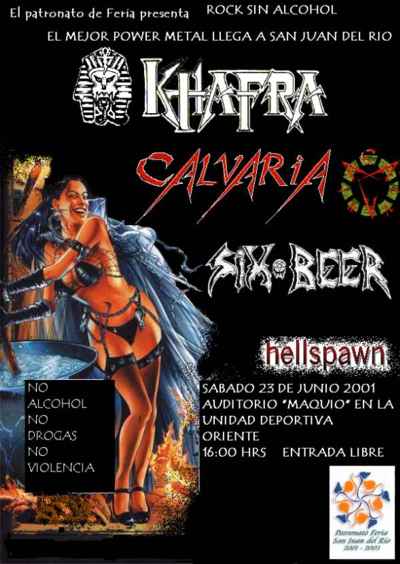
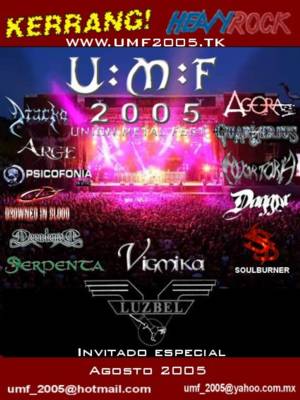
 Mexico hat als Land viel zu bieten, von endlosen Kaktuswüsten im Norden bis zu tropischem Dschungel im
Süden. Dazwischen zieht sich in voller Länge das riesige Sierra Madre Gebirge entlang. Heute noch ist es
selbst im Auto mühselig in endlosen Kurven über dieses Hinderniss von Ost nach West zu kommen. Zur
abwechslungsreichen Natur gibt es für jeden Besucher noch unendlich viele historische Sehenswürdigkeiten.
Vor allem die riesigen Ruinenstätten der Mayas und Azteken sind schwer beeindruckend. Das Essen ist
berühmt, wie auch die flüssige Nahrung Tequila und Mezcal (der mit dem Wurm drin!). Das Bier ist über
alle Zweifel erhaben und lässt die Amis im Norden ziemlich alt aussehen. Das Verhältniss zwischen den
beiden Nachbarn ist nicht besonders, was auch nicht verwunderlich ist nachdem die Amis sich riesige
Gebiete incl. Texas und Californien unter den Nagel gerissen haben. Frage nie einen Ami nach Mexico, da
herrscht bei ihnen die nackte Angst und jeder wird dir abraten. Sie kennen auch meistens nur die
Grenzorte die wirklich schlimm sind weil sich der ganze Abschaum dort versammelt um die Amis auszunehmen.
Mexico hat als Land viel zu bieten, von endlosen Kaktuswüsten im Norden bis zu tropischem Dschungel im
Süden. Dazwischen zieht sich in voller Länge das riesige Sierra Madre Gebirge entlang. Heute noch ist es
selbst im Auto mühselig in endlosen Kurven über dieses Hinderniss von Ost nach West zu kommen. Zur
abwechslungsreichen Natur gibt es für jeden Besucher noch unendlich viele historische Sehenswürdigkeiten.
Vor allem die riesigen Ruinenstätten der Mayas und Azteken sind schwer beeindruckend. Das Essen ist
berühmt, wie auch die flüssige Nahrung Tequila und Mezcal (der mit dem Wurm drin!). Das Bier ist über
alle Zweifel erhaben und lässt die Amis im Norden ziemlich alt aussehen. Das Verhältniss zwischen den
beiden Nachbarn ist nicht besonders, was auch nicht verwunderlich ist nachdem die Amis sich riesige
Gebiete incl. Texas und Californien unter den Nagel gerissen haben. Frage nie einen Ami nach Mexico, da
herrscht bei ihnen die nackte Angst und jeder wird dir abraten. Sie kennen auch meistens nur die
Grenzorte die wirklich schlimm sind weil sich der ganze Abschaum dort versammelt um die Amis auszunehmen. Ein Stück weg von der Grenze lernt man das normale Leben Mexicos kennen. Vor allem wenn man zu erkennen
gibt das man kein Gringo aus "Estados Unidos" ist, sondern aus Alemania kommt hat man schon mal bessere
Karten. Die Lebensumstände sind ähnlich wie in Argentinien: Korruption überall, Millionenschwerer
Reichtum ganz oben, bitterer Armut ganz unten und nichts dazwischen. Die wenigen hellhäutigen sind
natürlich von der Oberschicht, in der die noch stark indianisch aussehende Mehrheit nicht gerne gesehen
wird. Auch ist Mexico City ein unendlicher Moloch und liegt mit seinem ganzen Dreck und Abgas, von
Bergen umgeben wie in einer riesigen Schüssel in der die meiste Zeit des Jahres dicker Smog herrscht.
Da es auch noch ziemlich hoch liegt und die Luft sowieso ziemlich dünn ist sollten empfindliche Seelen
gar nicht erst dorthin. Hier wird natürlich wie in einem riesigen Schmelztiegel harter Stahl in allen
seinen Varianten gekocht. Durch die extremen Probleme überwiegt aber klar das radikale in Musik und
Texten. Es wird in spanisch und englisch gesungen deshalb trifft man auch ab und zu Leute die englisch
können.
Ein Stück weg von der Grenze lernt man das normale Leben Mexicos kennen. Vor allem wenn man zu erkennen
gibt das man kein Gringo aus "Estados Unidos" ist, sondern aus Alemania kommt hat man schon mal bessere
Karten. Die Lebensumstände sind ähnlich wie in Argentinien: Korruption überall, Millionenschwerer
Reichtum ganz oben, bitterer Armut ganz unten und nichts dazwischen. Die wenigen hellhäutigen sind
natürlich von der Oberschicht, in der die noch stark indianisch aussehende Mehrheit nicht gerne gesehen
wird. Auch ist Mexico City ein unendlicher Moloch und liegt mit seinem ganzen Dreck und Abgas, von
Bergen umgeben wie in einer riesigen Schüssel in der die meiste Zeit des Jahres dicker Smog herrscht.
Da es auch noch ziemlich hoch liegt und die Luft sowieso ziemlich dünn ist sollten empfindliche Seelen
gar nicht erst dorthin. Hier wird natürlich wie in einem riesigen Schmelztiegel harter Stahl in allen
seinen Varianten gekocht. Durch die extremen Probleme überwiegt aber klar das radikale in Musik und
Texten. Es wird in spanisch und englisch gesungen deshalb trifft man auch ab und zu Leute die englisch
können.
 Nur EL TRI und einige wenige andere überleben das Ende der 70er Jahre. Einer der wenigen Plätze, wo man
noch Rock Scheiben bekam, und spielen konnte war das "Hip 70" in Mexico City. Eine andere Band aus
dieser Zeit die auch einigen Einfluss auf die Heavy Szene hat mit ihrem Hard Rock Stil ist ENIGMA,
die Ende der 70er / Anfang der 80er etliche Alben veröffentlichen. 1980 entsteht der "Chopo" Markt und
entwickelt sich zum bis heute wichtigsten Treffpunkt für alles was mit Rock zu tun hat. Solch ein
Meeting und Angebot für Punks, Rocker, Ted`s, und Heavys hab ich noch nirgends gesehen. (Die Punkszene
ist extrem aktiv mit vielen Bands, Konzerten, Veröffentlichungen und sehr schillerndem Outfit). Nur auf
dem Chopo bekommt man z. B. alte Vinyl LP`s, Demos und Eigenproduktionen. Der Name kommt vom "Museo
cultural del Chopo" am ursprünglichen Standort, er ist aber mehrmals in der näheren Gegend umgezogen.
Nur EL TRI und einige wenige andere überleben das Ende der 70er Jahre. Einer der wenigen Plätze, wo man
noch Rock Scheiben bekam, und spielen konnte war das "Hip 70" in Mexico City. Eine andere Band aus
dieser Zeit die auch einigen Einfluss auf die Heavy Szene hat mit ihrem Hard Rock Stil ist ENIGMA,
die Ende der 70er / Anfang der 80er etliche Alben veröffentlichen. 1980 entsteht der "Chopo" Markt und
entwickelt sich zum bis heute wichtigsten Treffpunkt für alles was mit Rock zu tun hat. Solch ein
Meeting und Angebot für Punks, Rocker, Ted`s, und Heavys hab ich noch nirgends gesehen. (Die Punkszene
ist extrem aktiv mit vielen Bands, Konzerten, Veröffentlichungen und sehr schillerndem Outfit). Nur auf
dem Chopo bekommt man z. B. alte Vinyl LP`s, Demos und Eigenproduktionen. Der Name kommt vom "Museo
cultural del Chopo" am ursprünglichen Standort, er ist aber mehrmals in der näheren Gegend umgezogen.
 Anfang der 80er kommt auch die Metal Welle bis Mexico und erste Bands entstehen, covern aber erstmal nur.
Als erstes sind die grossen britischen Bands angesagt, und die SCORPIONS. Dann, als die ersten US Bands
bekannt werden, sind sie natürlich ein grosser Einfluss. Die ersten mexikanischen Bands entstehen auch
an der Grenzregion zur USA, da dort einfach die Versorgung mit Rock Musik besser ist (z.B. CRAZY LAZY
in Monterrey und DEATH WARRANT in Ciudad Juarez). Mitte der 80er spielen überall ersten Bands
eigenständige Sachen und eine eingeschworene Fan Szene entsteht die nichts anderes akzeptiert. Im
Gegensatz zu Argentinien entwickeln sich auch ausserhalb der Hauptstadt eigene aktive Szenen von denen
einige sogar LP`s veröffentlichen. CRAZY LAZY aus Monterrey sind mit ihrer Eigenproduktion sogar fast
die ersten Metaller die eine LP veröffentlichen. Als Spezialität der mexikanischen Metal Szene
entwickelt sich, eine völlig eigene Art von Slam Dance: In der Mitte steht der Hardcore Kern und bangt
was das Zeug hält und um sie herum kreisen in wilden Sprüngen die anderen. Das ganze erinnert an
indianische Tänze und ist nicht so unkontrolliert und aggressiv wie manchmal bei uns, und man sieht
auch viele Mädchen die mitmachen. Auffällig sind auch die vielen "Metalbrothers" im wahrsten Sinne des
Wortes, denn zwei Brüder pro Band sind schon fast normal und 3 keine Seltenheit und SIX BEER sind später
gar ein reines Familienunternehmen mit 4 Brüdern gewesen. Interessant ist auch, dass viele Heavy Musiker
zu der Zeit geschminkt und mit ausgefallenen Klamotten rumliefen. Die erste Welle der Metalbands singt
fast nur in spanisch, aber bis Ende der 80er setzt sich englisch immer mehr durch.
Anfang der 80er kommt auch die Metal Welle bis Mexico und erste Bands entstehen, covern aber erstmal nur.
Als erstes sind die grossen britischen Bands angesagt, und die SCORPIONS. Dann, als die ersten US Bands
bekannt werden, sind sie natürlich ein grosser Einfluss. Die ersten mexikanischen Bands entstehen auch
an der Grenzregion zur USA, da dort einfach die Versorgung mit Rock Musik besser ist (z.B. CRAZY LAZY
in Monterrey und DEATH WARRANT in Ciudad Juarez). Mitte der 80er spielen überall ersten Bands
eigenständige Sachen und eine eingeschworene Fan Szene entsteht die nichts anderes akzeptiert. Im
Gegensatz zu Argentinien entwickeln sich auch ausserhalb der Hauptstadt eigene aktive Szenen von denen
einige sogar LP`s veröffentlichen. CRAZY LAZY aus Monterrey sind mit ihrer Eigenproduktion sogar fast
die ersten Metaller die eine LP veröffentlichen. Als Spezialität der mexikanischen Metal Szene
entwickelt sich, eine völlig eigene Art von Slam Dance: In der Mitte steht der Hardcore Kern und bangt
was das Zeug hält und um sie herum kreisen in wilden Sprüngen die anderen. Das ganze erinnert an
indianische Tänze und ist nicht so unkontrolliert und aggressiv wie manchmal bei uns, und man sieht
auch viele Mädchen die mitmachen. Auffällig sind auch die vielen "Metalbrothers" im wahrsten Sinne des
Wortes, denn zwei Brüder pro Band sind schon fast normal und 3 keine Seltenheit und SIX BEER sind später
gar ein reines Familienunternehmen mit 4 Brüdern gewesen. Interessant ist auch, dass viele Heavy Musiker
zu der Zeit geschminkt und mit ausgefallenen Klamotten rumliefen. Die erste Welle der Metalbands singt
fast nur in spanisch, aber bis Ende der 80er setzt sich englisch immer mehr durch.
 Mitte der 80er wachen auch die ersten Plattenfirmen auf. "Comrock" nimmt LUZBEL und RAMSES unter Vertrag,
gehen aber bald Pleite, und werden von WEA geschluckt. Die Leute dort waren einfach zu unerfahren mit
dieser Art von Musik. Überhaupt fehlt die totale Infrastruktur, und alles ist noch ziemlich unorganisiert .
Aber 1986 setzen sich einige Bandmitglieder (Gustavo Solis von RAMSES; Arturo Huizar von LUZBEL und
Daniel Ojeda von CARONTE), Presseleute (Georgui Lazarov und Carlos Hernandez) und einige Fans zusammen
und gründen die "Escuadron Metalica". Sie wollen die Metalszene in allen Belangen unterstützen, vor
allem gemeinsame Konzerte veranstalten und Promotion machen, weshalb sie 1986 den Sampler "Escuadron
Metalica" herausbringen. Auf diesem spielen die neuen Metalhoffnungen GEHENNA; KHAFRA; Z und ASPID.
Diese Scheibe erschien auf dem Label "Discos Rosenbach", welches dem Drummer Victor Baldorinos von den
Prog Rockern ICONOCLAST gehört, der auch der offizielle Produzent der "Escuadron" ist. Alle anderen
wichtigen Bands der Zeit waren auch Mitglieder, wie z.B. ULTIMATUM: APOCALIPSIS; MEGATON und viele die
es nur zu einem Demo brachten wie DEATH WARRANT; VIRGIN WITCH; SUPER ALFA; ABADDON; ALUCARD; AUSTER und
viele mehr. Lazarov (ein ausgewanderter Bulgare) und Carlos F. Hernandez engagieren sich aber noch
weiter, und gründen das "Heavy Metal Subterraneo" Fanzine (die ersten 4 Nummern als Beilage zur Musik
Zeitschrift "Connecte", bei der sie arbeiteten). Sie gründen auch das "Avanzada Metalica" Label, das die
"Escuadron Metalico" Serie fortführt, und vielen neuen Bands eine Chance gibt, und ihre Platten
herausbringt (TRANSMETAL; NEXT; INQUISIDOR; Z; KHAFRA und mehr).
Mitte der 80er wachen auch die ersten Plattenfirmen auf. "Comrock" nimmt LUZBEL und RAMSES unter Vertrag,
gehen aber bald Pleite, und werden von WEA geschluckt. Die Leute dort waren einfach zu unerfahren mit
dieser Art von Musik. Überhaupt fehlt die totale Infrastruktur, und alles ist noch ziemlich unorganisiert .
Aber 1986 setzen sich einige Bandmitglieder (Gustavo Solis von RAMSES; Arturo Huizar von LUZBEL und
Daniel Ojeda von CARONTE), Presseleute (Georgui Lazarov und Carlos Hernandez) und einige Fans zusammen
und gründen die "Escuadron Metalica". Sie wollen die Metalszene in allen Belangen unterstützen, vor
allem gemeinsame Konzerte veranstalten und Promotion machen, weshalb sie 1986 den Sampler "Escuadron
Metalica" herausbringen. Auf diesem spielen die neuen Metalhoffnungen GEHENNA; KHAFRA; Z und ASPID.
Diese Scheibe erschien auf dem Label "Discos Rosenbach", welches dem Drummer Victor Baldorinos von den
Prog Rockern ICONOCLAST gehört, der auch der offizielle Produzent der "Escuadron" ist. Alle anderen
wichtigen Bands der Zeit waren auch Mitglieder, wie z.B. ULTIMATUM: APOCALIPSIS; MEGATON und viele die
es nur zu einem Demo brachten wie DEATH WARRANT; VIRGIN WITCH; SUPER ALFA; ABADDON; ALUCARD; AUSTER und
viele mehr. Lazarov (ein ausgewanderter Bulgare) und Carlos F. Hernandez engagieren sich aber noch
weiter, und gründen das "Heavy Metal Subterraneo" Fanzine (die ersten 4 Nummern als Beilage zur Musik
Zeitschrift "Connecte", bei der sie arbeiteten). Sie gründen auch das "Avanzada Metalica" Label, das die
"Escuadron Metalico" Serie fortführt, und vielen neuen Bands eine Chance gibt, und ihre Platten
herausbringt (TRANSMETAL; NEXT; INQUISIDOR; Z; KHAFRA und mehr).
 Ab 1986 gibt es immer mehr Metal
Konzerte und ab 1987 mit dem "Festival Metalero Azteca" das erste Grossereigniss mit allem was Rang und
Namen hat. Lazarov und Hernandez veranstalten Metal Video Shows mit anschliessenden Konzerten, die in
den nächsten Jahren einen wichtigen Schub in die Szene bringen. 1988 kommen die ersten ausländischen
Bands, die allerersten sind 3 dralle Latinas aus der alten heimischen Provinz Texas die sich HEATHER
LEATHER nennen (von denen gibt's eine ultrarare Single von 1987). Es folgen V. RUMORS, DEATH, A. DEL
INFIERNO und mehr, auch wird 1988 das absolute Festivaljahr mit mehreren Treffen die nun jedes Jahr
folgen. Gegen die immer noch üblichen Übergriffe und Razzien der Polizei und die immer drohene
Schliessung des Chopo Marktes gibt es jedes Jahr in mehreren Städten Demos und Veranstaltungen. Extrem
schneller Thrash Metal mit brutalen oder anklagenden Texten, wie ihn TRANSMETAL; INQUISIDOR; NEXT;
LEPROSY und andere spielen wird sehr beliebt. Es gibt aber auch hier für lange Zeit diese räudigen
Poserbands, z.B. MARA und VAGO. Erstaunlich, und weltweit wohl einmalig ist aber, dass bei vielen
kleinen Festivals ("Chancoques" genannt) diese Bands problemlos mit den Metal Bands oder sogar den
extremen Thrash Bands zusammen spielen, und auch die verschiedenen Fans keine Probleme untereinander
haben. Selbst reine Rock Bands wie EL TRI spielen manchmal mit extremen Metal Bands zusammen! In Mexico
erscheinen sogar einige echt geile US Bands allein hier auf Platte und CD (natürlich bei "Avanzada").
Ab 1986 gibt es immer mehr Metal
Konzerte und ab 1987 mit dem "Festival Metalero Azteca" das erste Grossereigniss mit allem was Rang und
Namen hat. Lazarov und Hernandez veranstalten Metal Video Shows mit anschliessenden Konzerten, die in
den nächsten Jahren einen wichtigen Schub in die Szene bringen. 1988 kommen die ersten ausländischen
Bands, die allerersten sind 3 dralle Latinas aus der alten heimischen Provinz Texas die sich HEATHER
LEATHER nennen (von denen gibt's eine ultrarare Single von 1987). Es folgen V. RUMORS, DEATH, A. DEL
INFIERNO und mehr, auch wird 1988 das absolute Festivaljahr mit mehreren Treffen die nun jedes Jahr
folgen. Gegen die immer noch üblichen Übergriffe und Razzien der Polizei und die immer drohene
Schliessung des Chopo Marktes gibt es jedes Jahr in mehreren Städten Demos und Veranstaltungen. Extrem
schneller Thrash Metal mit brutalen oder anklagenden Texten, wie ihn TRANSMETAL; INQUISIDOR; NEXT;
LEPROSY und andere spielen wird sehr beliebt. Es gibt aber auch hier für lange Zeit diese räudigen
Poserbands, z.B. MARA und VAGO. Erstaunlich, und weltweit wohl einmalig ist aber, dass bei vielen
kleinen Festivals ("Chancoques" genannt) diese Bands problemlos mit den Metal Bands oder sogar den
extremen Thrash Bands zusammen spielen, und auch die verschiedenen Fans keine Probleme untereinander
haben. Selbst reine Rock Bands wie EL TRI spielen manchmal mit extremen Metal Bands zusammen! In Mexico
erscheinen sogar einige echt geile US Bands allein hier auf Platte und CD (natürlich bei "Avanzada"). Ende der 80er nehmen die Labels "Denver" und "Gas" viele Metal Bands unter Vertrag. Fast alle Scheiben
von "Gas Discos" sind selten, da bei denen alles nach einer Weile alles weggeschmissen wurde was nicht
verkauft wurde. Anfang der 90er kommen erst die ersten richtig grossen internationalen Metal Bands.
Pech hatten 1990 OBUS aus Spanien, nur wenige kamen zu ihren Konzerten da gerade ein anderer auf Tournee
war - der Papst! Extremerer Metal wird immer beliebter, Texte und Motive aus der blutigen Azteken- und
Mayazeit bieten sich ja auch ideal für Death Metal Bands an. Mitte der 90er wächst die Szene
Lateinamerikas immer mehr zusammen (durch MTV- Latino??). TRANSMETAL (die seit Ende der 80er zur
grössten Mexikanischen Band wurden) touren in anderen Latino Ländern (inkl. den US- Städten mit grossem
Latino Anteil), und Bands von dort kommen nach Mexico. 1996 gibt es das riesige "Festival
Latinoamericano" mit Bands aus Argentinien (MALON), Chile (CRIMINAL), Uruguay (INNER SANCTUM) u.s.w. Auch gibt es zum 10 jährigen
bestehen des "Heavy Metal Subterraneo" Fanzines das ultimative Festival mit 31 einheimischen Bands.
Ende der 80er nehmen die Labels "Denver" und "Gas" viele Metal Bands unter Vertrag. Fast alle Scheiben
von "Gas Discos" sind selten, da bei denen alles nach einer Weile alles weggeschmissen wurde was nicht
verkauft wurde. Anfang der 90er kommen erst die ersten richtig grossen internationalen Metal Bands.
Pech hatten 1990 OBUS aus Spanien, nur wenige kamen zu ihren Konzerten da gerade ein anderer auf Tournee
war - der Papst! Extremerer Metal wird immer beliebter, Texte und Motive aus der blutigen Azteken- und
Mayazeit bieten sich ja auch ideal für Death Metal Bands an. Mitte der 90er wächst die Szene
Lateinamerikas immer mehr zusammen (durch MTV- Latino??). TRANSMETAL (die seit Ende der 80er zur
grössten Mexikanischen Band wurden) touren in anderen Latino Ländern (inkl. den US- Städten mit grossem
Latino Anteil), und Bands von dort kommen nach Mexico. 1996 gibt es das riesige "Festival
Latinoamericano" mit Bands aus Argentinien (MALON), Chile (CRIMINAL), Uruguay (INNER SANCTUM) u.s.w. Auch gibt es zum 10 jährigen
bestehen des "Heavy Metal Subterraneo" Fanzines das ultimative Festival mit 31 einheimischen Bands.
 Das alles sollte nicht darüber hinwegtäuschen dass die Metal Szene heute hauptsächlich aus Death / Black
Metal Bands besteht (oder alten Thrash Bands die mittlerweile so heftig sind daß man es fast schon als
Daeth Metal bezeichnen kann). Traditionelle Metal Bands musste man Mitte der 90er mit der Lupe im
Untergrund suchen aber es gab sie noch (im Gegensatz zum Bericht im "Iron Pages" Nr. 2/98).
Auch gibt es immer noch LUZBEL
(als letzte Band aus der Anfangszeit), aber sie haben bei weitem nicht mehr die Bedeutung wie früher.
Dafür wurde eine andere Band sozusagen mexikanisch. 2 Leute von ANGELOS DEL INFIERNO
sind nach einigen umjubelten Tourneen Mitte der 90er ganz von Spanien nach Mexico gezogen und nach
Integration von 2 mexikanischen Leuten dort Live sehr aktiv gewesen (sie sind aber mittlerweile
in die USA weitergezogen) Auch war die Band von AGENT STEEL Gitarrist Juan Garcia, TERROR
hauptsächlich in der alten Heimat Mexico aktiv. Obwohl ich zugeben muss, dass viele von den
neuen mexikanischen Death Metal Bands sehr gut sind, habe ich immer gehofft, dass True Metal
dort wieder mehr Bedeutung bekommen wird. Seit ca. 2000 sieht es auch schon wieder besser aus!
In den letzten Jahren kamen interessante CDs heraus, wie z.B. CALVARIO; SANTO OFICIO;
PROYECTO MILENIUM; EROGENA; ANDARTA; ALIOTH; ARGOS und mehr. Auch die alte progressiv Band IRA
wurde eine echte Power Kapelle. Es wurden auch viele alte Alben auf CD wiederveröffentlicht,
wie RAMSES; MEGATON; SIX BEER; NEXT; KHAFRA und andere!
Das alles sollte nicht darüber hinwegtäuschen dass die Metal Szene heute hauptsächlich aus Death / Black
Metal Bands besteht (oder alten Thrash Bands die mittlerweile so heftig sind daß man es fast schon als
Daeth Metal bezeichnen kann). Traditionelle Metal Bands musste man Mitte der 90er mit der Lupe im
Untergrund suchen aber es gab sie noch (im Gegensatz zum Bericht im "Iron Pages" Nr. 2/98).
Auch gibt es immer noch LUZBEL
(als letzte Band aus der Anfangszeit), aber sie haben bei weitem nicht mehr die Bedeutung wie früher.
Dafür wurde eine andere Band sozusagen mexikanisch. 2 Leute von ANGELOS DEL INFIERNO
sind nach einigen umjubelten Tourneen Mitte der 90er ganz von Spanien nach Mexico gezogen und nach
Integration von 2 mexikanischen Leuten dort Live sehr aktiv gewesen (sie sind aber mittlerweile
in die USA weitergezogen) Auch war die Band von AGENT STEEL Gitarrist Juan Garcia, TERROR
hauptsächlich in der alten Heimat Mexico aktiv. Obwohl ich zugeben muss, dass viele von den
neuen mexikanischen Death Metal Bands sehr gut sind, habe ich immer gehofft, dass True Metal
dort wieder mehr Bedeutung bekommen wird. Seit ca. 2000 sieht es auch schon wieder besser aus!
In den letzten Jahren kamen interessante CDs heraus, wie z.B. CALVARIO; SANTO OFICIO;
PROYECTO MILENIUM; EROGENA; ANDARTA; ALIOTH; ARGOS und mehr. Auch die alte progressiv Band IRA
wurde eine echte Power Kapelle. Es wurden auch viele alte Alben auf CD wiederveröffentlicht,
wie RAMSES; MEGATON; SIX BEER; NEXT; KHAFRA und andere! The country of Mexico has much to offer, from deserts full of cactus in the north, to tropical jungles
in the south. Situated in between are the Sierra Madre mountains. Still today it is hard to travel the
endless bends of the roads over this obstacle in a car. The visitor awaits not only great nature, but
also hundreds of historic sites. Especially the ruins of the Aztec and Maya time are very impressive.
The spicy food and the drinks, like Tequila and Mezcal (with the worm in the bottle) are famous. The
beer is very good, and much better than the ones from the Anglo Americans! The relationship with their
northern neighbors is not very good, which is no wonder, as the USA took huge territories from them,
including Texas, Arizona and California. Never ask an US American about travelling in Mexico! They all
will advice you not to do it, as they are very afraid of this country. Most of them know only the border
towns, who are really bad and full of crooks who try to rip-off tourists. But if you travel further
inland you will get to know the real life, and the friendliness of Mexican people. Especially when they
see that you aren't a "Gringo" from the US, you will have less problems.
The country of Mexico has much to offer, from deserts full of cactus in the north, to tropical jungles
in the south. Situated in between are the Sierra Madre mountains. Still today it is hard to travel the
endless bends of the roads over this obstacle in a car. The visitor awaits not only great nature, but
also hundreds of historic sites. Especially the ruins of the Aztec and Maya time are very impressive.
The spicy food and the drinks, like Tequila and Mezcal (with the worm in the bottle) are famous. The
beer is very good, and much better than the ones from the Anglo Americans! The relationship with their
northern neighbors is not very good, which is no wonder, as the USA took huge territories from them,
including Texas, Arizona and California. Never ask an US American about travelling in Mexico! They all
will advice you not to do it, as they are very afraid of this country. Most of them know only the border
towns, who are really bad and full of crooks who try to rip-off tourists. But if you travel further
inland you will get to know the real life, and the friendliness of Mexican people. Especially when they
see that you aren't a "Gringo" from the US, you will have less problems. The life is the same as in most
Latin American countries. You have on one hand very rich people and on the other very poor, and almost
nothing in between. The few pale skinned people are of course from the upper class, and don't like
people from the dark skinned, Indian looking majority in their midst. Mexico city is a gigantic
metropolis, surrounded by high mountains like a bowl, and all the pollution smog stays in there most of
the year. The altitude is also very high, and because of this the air is thinner, so, sensitive souls
should stay away. This is also like a big melting pot for hard steel in all its variations. Because of
the extreme problems the radical music and lyrics prevail. Bands sing in Spanish and English, and you
can find more people who speak English, than in other Latin American countries.
The life is the same as in most
Latin American countries. You have on one hand very rich people and on the other very poor, and almost
nothing in between. The few pale skinned people are of course from the upper class, and don't like
people from the dark skinned, Indian looking majority in their midst. Mexico city is a gigantic
metropolis, surrounded by high mountains like a bowl, and all the pollution smog stays in there most of
the year. The altitude is also very high, and because of this the air is thinner, so, sensitive souls
should stay away. This is also like a big melting pot for hard steel in all its variations. Because of
the extreme problems the radical music and lyrics prevail. Bands sing in Spanish and English, and you
can find more people who speak English, than in other Latin American countries.
 The history of Rock music in Mexico started in the 60s with bands who covered US Rock. But most of this
bands did not know English and did not border with translation of the lyrics, they just wrote their own
lyrics for the songs. End of the 60s the first independent bands appeared with their own songs, and in
Spanish language, which aroused the enthusiasm of the youth. The first who got really known was LA
REVOLUTION DE EMILIANO ZAPATA. They were followed by TONCHO PILATOS (with the first critical lyrics),
THREE SOULS IN MY MIND (till today under the name EL TRI the absolute Rock institution) and more. The
first heavier bands came with EL RITUAL (the first LP 1971 is good Hard Rock) and NAHUATL (their first
LP 1975 is really good and for its time absolutely heavy, the second is bad). Woodstock inspired their
own scene very much and they organized their own festival "Avandaro" 1971 (with 150 000 audience). Here
on stage they agitated against the government and the misery. The government waited already for a reason
like that, and started together with the media a witch hunt against the "dirty, drug addicted,
communistic and violent" Rock fans.
The history of Rock music in Mexico started in the 60s with bands who covered US Rock. But most of this
bands did not know English and did not border with translation of the lyrics, they just wrote their own
lyrics for the songs. End of the 60s the first independent bands appeared with their own songs, and in
Spanish language, which aroused the enthusiasm of the youth. The first who got really known was LA
REVOLUTION DE EMILIANO ZAPATA. They were followed by TONCHO PILATOS (with the first critical lyrics),
THREE SOULS IN MY MIND (till today under the name EL TRI the absolute Rock institution) and more. The
first heavier bands came with EL RITUAL (the first LP 1971 is good Hard Rock) and NAHUATL (their first
LP 1975 is really good and for its time absolutely heavy, the second is bad). Woodstock inspired their
own scene very much and they organized their own festival "Avandaro" 1971 (with 150 000 audience). Here
on stage they agitated against the government and the misery. The government waited already for a reason
like that, and started together with the media a witch hunt against the "dirty, drug addicted,
communistic and violent" Rock fans. Already after the big massacre against students at the Olympic games
1968 (with hundreds of victims) the government fought against Rock music. But now the whole scene got
oppressed, concerts were forbidden, clubs closed, Rock in Radio was forbidden, Rock magazines censored
and so forth. This really killed the scene, who was not very big at this time, and many bands quit.
One of the only places where you could get Rock records and could play was the "Hip 70" shop in Mexico City.
Only EL TRI and a few other bands survived to the end of the 70s. Another band from this time who had a
big influence at the Heavy scene was ENIGMA, who made end of the 70s / beginning of the 80s several
progressive Hard Rock albums. In 1980 started the "Chopo" flea market which developed into the most
important meeting and dealing point for everything that had to do with Rock music. It still exists today
and you can see Rockers, Heavys, Punks and Teds, and only there you will get old vinyl LPs, independent
CDs, demo stuff, fanzines and more. The name comes from the "Museo cultural del Chopo", where it started
first, but has now moved several times in the neigbourhood.
Already after the big massacre against students at the Olympic games
1968 (with hundreds of victims) the government fought against Rock music. But now the whole scene got
oppressed, concerts were forbidden, clubs closed, Rock in Radio was forbidden, Rock magazines censored
and so forth. This really killed the scene, who was not very big at this time, and many bands quit.
One of the only places where you could get Rock records and could play was the "Hip 70" shop in Mexico City.
Only EL TRI and a few other bands survived to the end of the 70s. Another band from this time who had a
big influence at the Heavy scene was ENIGMA, who made end of the 70s / beginning of the 80s several
progressive Hard Rock albums. In 1980 started the "Chopo" flea market which developed into the most
important meeting and dealing point for everything that had to do with Rock music. It still exists today
and you can see Rockers, Heavys, Punks and Teds, and only there you will get old vinyl LPs, independent
CDs, demo stuff, fanzines and more. The name comes from the "Museo cultural del Chopo", where it started
first, but has now moved several times in the neigbourhood.
 Beginning of the 80s the Metal wave arrived also in Mexico, but the first bands played only cover songs.
First the big English bands and the SCORPIONS became popular, and when the US scene started they loved
the bands from there. The big Mexican cities at the border to the USA herd all this stuff first, and
because of that had some of the first Metal bands in the country. Two of them were CRAZY LAZY from
Monterrey and DEATH WARRANT from Ciudad Juarez. By the mid 80s appeared the first bands that played
their own material, and a fan scene developed, who was very radical and didn't accept anything else.
Contrary to other Latin countries they had also active scenes outside of the capital. One of the first
who made an album, and did it even independently was CRAZY LAZY from Monterey. A unique Mexican Metal
slam dance developed at live concerts: in the middle is the hard core center which bangs and screams,
and around in a circles is a wild jumping and dancing crowd. This reminds a lot of the old Indian dances,
and is not as violent as the "pit" in Europe or the US. You can even see a lot of girls in the crowd.
Unique are also the many "Metal brothers", as in many bands two or 3 brothers are no rarity, and SIX BEERS
had even 4 brothers! Many bands at that time used make-up, and had very strange outfit.
Beginning of the 80s the Metal wave arrived also in Mexico, but the first bands played only cover songs.
First the big English bands and the SCORPIONS became popular, and when the US scene started they loved
the bands from there. The big Mexican cities at the border to the USA herd all this stuff first, and
because of that had some of the first Metal bands in the country. Two of them were CRAZY LAZY from
Monterrey and DEATH WARRANT from Ciudad Juarez. By the mid 80s appeared the first bands that played
their own material, and a fan scene developed, who was very radical and didn't accept anything else.
Contrary to other Latin countries they had also active scenes outside of the capital. One of the first
who made an album, and did it even independently was CRAZY LAZY from Monterey. A unique Mexican Metal
slam dance developed at live concerts: in the middle is the hard core center which bangs and screams,
and around in a circles is a wild jumping and dancing crowd. This reminds a lot of the old Indian dances,
and is not as violent as the "pit" in Europe or the US. You can even see a lot of girls in the crowd.
Unique are also the many "Metal brothers", as in many bands two or 3 brothers are no rarity, and SIX BEERS
had even 4 brothers! Many bands at that time used make-up, and had very strange outfit. The first wave of
Metal bands sung almost all in Spanish, but by the end of the 80s more and more used English.
The first record companies woke up too, and "Comrock" signed LUZBEL and RAMSES, but soon went bankrupt,
and WEA swallowed them. They were too unexperienced with Metal bands, as the whole new scene was. To
change this some band members (Gustavo Solis from RAMSES; Arturo Huizar from LUZBEL and Daniel Ojeda
from CARONTE), some guys from the Rock media (Georgui Lazarov and Carlos Hernandez) and some fans
founded the "Escuadron Metalico" in 1986. They planned to organize concerts, and to promote Metal bands
in any way possible. One idea was to release the compilation LP "Escuadron Metalica" in the same year,
with the new Metal hopefuls GEHENNA; KHAFRA and ASPID. It was released on the label "Discos Rosenbach"
which was owned by the drummer Victor Baldorinos from the Prog Rock band ICONOCLAST, who was also the
official producer of the "Escuadron". Most of the other important bands from this time were also
members, like ULTIMATUM; APOCALIPSIS; MEGATON and many more, who were only able to release demos, like
DEATH WARRANT; VIRGIN WITCH; SUPER ALFA; ABADDON; ALUCARD; AUSTER; ASPID. Lazarov (who immigrated from
Bulgaria) and Hernandez were even more active and founded their own label "Avanzada Metalica" which
continued with 2 more "Escuadron Metalica" compilations, and released a lot of records from the new
wave of popular bands like TRANSMETAL; NEXT; INQUISIDOR; Z; KHAFRA; GEHENNA and many more. They also
founded the first real Metal fanzine "Heavy Metal Suzbterraneo, which was first an supplement to the
"Connecte" Rock magazine, where the 2 guys worked. Starting with number 5 it was independent and became
one of the best fanzines in the world.
The first wave of
Metal bands sung almost all in Spanish, but by the end of the 80s more and more used English.
The first record companies woke up too, and "Comrock" signed LUZBEL and RAMSES, but soon went bankrupt,
and WEA swallowed them. They were too unexperienced with Metal bands, as the whole new scene was. To
change this some band members (Gustavo Solis from RAMSES; Arturo Huizar from LUZBEL and Daniel Ojeda
from CARONTE), some guys from the Rock media (Georgui Lazarov and Carlos Hernandez) and some fans
founded the "Escuadron Metalico" in 1986. They planned to organize concerts, and to promote Metal bands
in any way possible. One idea was to release the compilation LP "Escuadron Metalica" in the same year,
with the new Metal hopefuls GEHENNA; KHAFRA and ASPID. It was released on the label "Discos Rosenbach"
which was owned by the drummer Victor Baldorinos from the Prog Rock band ICONOCLAST, who was also the
official producer of the "Escuadron". Most of the other important bands from this time were also
members, like ULTIMATUM; APOCALIPSIS; MEGATON and many more, who were only able to release demos, like
DEATH WARRANT; VIRGIN WITCH; SUPER ALFA; ABADDON; ALUCARD; AUSTER; ASPID. Lazarov (who immigrated from
Bulgaria) and Hernandez were even more active and founded their own label "Avanzada Metalica" which
continued with 2 more "Escuadron Metalica" compilations, and released a lot of records from the new
wave of popular bands like TRANSMETAL; NEXT; INQUISIDOR; Z; KHAFRA; GEHENNA and many more. They also
founded the first real Metal fanzine "Heavy Metal Suzbterraneo, which was first an supplement to the
"Connecte" Rock magazine, where the 2 guys worked. Starting with number 5 it was independent and became
one of the best fanzines in the world.
 Since 1986 more and more concerts were organized, and in 1987 started the "Festival Metalero Azteca"
who was the first big Metal event with many of the most important bands of that time. Lazarov and the
other maker of the "HM Subterraneo" mag, organized Metal video shows followed by concerts, which
brought a big push into the scene. In 1988 the first international bands appeared. The very first were
3 hot Latina girls from the old province of Texas, with their band HEATHER LEATHER (they made a ultra
rare 7" single). They were followed by VICIOUS RUMORS; DEATH; ANGELES DEL INFIERNO and many more. 1988
was the ultimate festival year, with many of them and some followed every year. Against the still
existing violence and round-ups of the Police, and the everlasting threat of the close-down of the
"Chopo" market they organized demonstrations in several cities, which continued many years.
Since 1986 more and more concerts were organized, and in 1987 started the "Festival Metalero Azteca"
who was the first big Metal event with many of the most important bands of that time. Lazarov and the
other maker of the "HM Subterraneo" mag, organized Metal video shows followed by concerts, which
brought a big push into the scene. In 1988 the first international bands appeared. The very first were
3 hot Latina girls from the old province of Texas, with their band HEATHER LEATHER (they made a ultra
rare 7" single). They were followed by VICIOUS RUMORS; DEATH; ANGELES DEL INFIERNO and many more. 1988
was the ultimate festival year, with many of them and some followed every year. Against the still
existing violence and round-ups of the Police, and the everlasting threat of the close-down of the
"Chopo" market they organized demonstrations in several cities, which continued many years. Extreme fast Thrash Metal with brutal or accusing lyrics got more and more popular. This was played by
bands like TRANSMETAL; INQUISIDOR; NEXT; WRECKER and more.
But like in other countries there were also
this ugly Poser bands for many years, like MARA and VAGO. But different then in the rest of the world,
at the small festivals called "Chancoques", this kind of bands play together with extreme Thrash bands,
and even the fans come along with each other. Sometimes even normal Rock bands like EL TRI play
together with Thrash bands.
On the "Avanzada" label they even released exclusively some US bands. End of the 80s the labels "Denver"
and "Gas" started to release a lot of Metal. Almost all records of "Gas" are rare today, as they threw
away all the records which they did not sell! Beginning of the 90s came the first real big international
bands. Bad luck had the Spanish OBUS in 1990, as almost nobody came to their shows. This was because a
bigger international act was touring, ......the Pope! 1992 was a happy year for the Metal fans, as
TRANSMETAL got together again with their original singer, and LUZBEL united again too.
Extreme fast Thrash Metal with brutal or accusing lyrics got more and more popular. This was played by
bands like TRANSMETAL; INQUISIDOR; NEXT; WRECKER and more.
But like in other countries there were also
this ugly Poser bands for many years, like MARA and VAGO. But different then in the rest of the world,
at the small festivals called "Chancoques", this kind of bands play together with extreme Thrash bands,
and even the fans come along with each other. Sometimes even normal Rock bands like EL TRI play
together with Thrash bands.
On the "Avanzada" label they even released exclusively some US bands. End of the 80s the labels "Denver"
and "Gas" started to release a lot of Metal. Almost all records of "Gas" are rare today, as they threw
away all the records which they did not sell! Beginning of the 90s came the first real big international
bands. Bad luck had the Spanish OBUS in 1990, as almost nobody came to their shows. This was because a
bigger international act was touring, ......the Pope! 1992 was a happy year for the Metal fans, as
TRANSMETAL got together again with their original singer, and LUZBEL united again too.
 The extreme Metal got more and more popular. Death Metal bands realized, that lyrics and artwork from
the bloody Aztec and Maya times would fit ideal to their music. In the mid 80s the Latino Metal scene
growed together (through "MTV Latino"?). TRANSMETAL, who became end of the 80s the biggest Metal band in
the country, toured in other Latin American countries, and in US towns with high Latino population. In
1996 was the big "Festival Latinoamericano" with bands from Argentina (MALON), Chile (CRIMAINAL) and
more. In the same year was also the ultimate Mexican Metal festival for the 10 years celebration of
"Heavy Metal Subterraneo" fanzine, with 31 local bands!
The extreme Metal got more and more popular. Death Metal bands realized, that lyrics and artwork from
the bloody Aztec and Maya times would fit ideal to their music. In the mid 80s the Latino Metal scene
growed together (through "MTV Latino"?). TRANSMETAL, who became end of the 80s the biggest Metal band in
the country, toured in other Latin American countries, and in US towns with high Latino population. In
1996 was the big "Festival Latinoamericano" with bands from Argentina (MALON), Chile (CRIMAINAL) and
more. In the same year was also the ultimate Mexican Metal festival for the 10 years celebration of
"Heavy Metal Subterraneo" fanzine, with 31 local bands!
 This all should not mislead you, because fact
is, that today the Mexican Metal scene consist mainly of Death and Black Metal bands. The old
still existing Thrash Metal acts became also much extremer and are almost like Death Metal
bands. Traditional Metal bands you had to search with a microscope at the middle and end of the
90s, but they still existed. LUZBEL exist still too, and plays the old style, but they don't
have the same status like in the 80s anymore. But another famous band became more or less
Mexican, ANGELES DEL INFIERNO moved to Mexico after some successful tours. They had two Mexican
members, but moved later to the US. Another band that was more active in Mexico was TERROR,
the band of Juan Garcia from AGENT STEEL. I must admit, that
some of the Death Metal bands from Mexico are really good, but I always hoped the True Metal
will become bigger again. Contrary to Argentina and Brazil it did not look very good, and you
had to be glad, if Metal survived in the underground. But since around the year 2000 it looks
better, and a lot of new bands appeared, like CALVARIA; SANTO OFICIO; PROYECTO MILENIO; EROGENA;
ANDARTA; ALIOTH; ARGOS and more. The older progressive band IRA became also a real
Power Metal band, and even the old CRYSTAL Y ACERO give full Power now.
There were also many re releases of old albums on CD, like from RAMSES; MEGATON; SIX BEER;
NEXT; KHAFRA and more!
This all should not mislead you, because fact
is, that today the Mexican Metal scene consist mainly of Death and Black Metal bands. The old
still existing Thrash Metal acts became also much extremer and are almost like Death Metal
bands. Traditional Metal bands you had to search with a microscope at the middle and end of the
90s, but they still existed. LUZBEL exist still too, and plays the old style, but they don't
have the same status like in the 80s anymore. But another famous band became more or less
Mexican, ANGELES DEL INFIERNO moved to Mexico after some successful tours. They had two Mexican
members, but moved later to the US. Another band that was more active in Mexico was TERROR,
the band of Juan Garcia from AGENT STEEL. I must admit, that
some of the Death Metal bands from Mexico are really good, but I always hoped the True Metal
will become bigger again. Contrary to Argentina and Brazil it did not look very good, and you
had to be glad, if Metal survived in the underground. But since around the year 2000 it looks
better, and a lot of new bands appeared, like CALVARIA; SANTO OFICIO; PROYECTO MILENIO; EROGENA;
ANDARTA; ALIOTH; ARGOS and more. The older progressive band IRA became also a real
Power Metal band, and even the old CRYSTAL Y ACERO give full Power now.
There were also many re releases of old albums on CD, like from RAMSES; MEGATON; SIX BEER;
NEXT; KHAFRA and more! El país de México tiene mucho que ofrecer, desde los desiertos llenos de cáctus
en el norte hasta las selvas tropicales en el sur. En medio están
ubicadas las montañas de la Sierra Madre. Aún hoy en día es difícil viajar
en coche por las interminables curvas de las carreteras de este obstáculo
natural. Al visitante lo esperan no solamente una gran naturaleza, sino también
cientos de sitios históricos. Las ruinas mayas y los
aztecas son muy impresionantes. La comida picante y las bebidas alcohólicas
como el tequila y el mezcal (con el gusanito en la botella) son famosas. La
cerveza es muy buena, ¡mucho mejor que la de los anglo americanos!
La relación con sus vecinos del norte no es muy buena, lo cual no es de
extrañar ya que Estados Unidos se apropió de grandes territorios entre los
que se pueden mencionar Texas, Arizona, Nuevo México y California. ¡Nunca le
pregunten a un estadounidense acerca de viajar a México! Todos te
aconsejarían de no hacerlo ya que ellos le temen a ese país. La mayoría de
ellos conocen solamente los pueblos fronterizos los cuales son realmente
malos y llenos de ladrones y transas que tratan de estafar a los turistas.
Pero si viajas en el interior llegarás a conocer la verdadera vida y lo
amistosos que son los mexicanos, especialmente cuando se dan cuenta de que
no eres "gringo" de Estados Unidos. Así tendrás menos problemas.
La vida es la misma que en la mayoría de los países latinoamericanos. Por un
lado tienes una minoría de gente muy rica y por el otro a una mayoría de
gente muy pobre, con casi nada en el medio. La poca gente de piel clara son
en su mayoría de la clase acomodada y evita, rechaza y discrimina a los de
piel oscura, en su mayoría de origen indígena.
El país de México tiene mucho que ofrecer, desde los desiertos llenos de cáctus
en el norte hasta las selvas tropicales en el sur. En medio están
ubicadas las montañas de la Sierra Madre. Aún hoy en día es difícil viajar
en coche por las interminables curvas de las carreteras de este obstáculo
natural. Al visitante lo esperan no solamente una gran naturaleza, sino también
cientos de sitios históricos. Las ruinas mayas y los
aztecas son muy impresionantes. La comida picante y las bebidas alcohólicas
como el tequila y el mezcal (con el gusanito en la botella) son famosas. La
cerveza es muy buena, ¡mucho mejor que la de los anglo americanos!
La relación con sus vecinos del norte no es muy buena, lo cual no es de
extrañar ya que Estados Unidos se apropió de grandes territorios entre los
que se pueden mencionar Texas, Arizona, Nuevo México y California. ¡Nunca le
pregunten a un estadounidense acerca de viajar a México! Todos te
aconsejarían de no hacerlo ya que ellos le temen a ese país. La mayoría de
ellos conocen solamente los pueblos fronterizos los cuales son realmente
malos y llenos de ladrones y transas que tratan de estafar a los turistas.
Pero si viajas en el interior llegarás a conocer la verdadera vida y lo
amistosos que son los mexicanos, especialmente cuando se dan cuenta de que
no eres "gringo" de Estados Unidos. Así tendrás menos problemas.
La vida es la misma que en la mayoría de los países latinoamericanos. Por un
lado tienes una minoría de gente muy rica y por el otro a una mayoría de
gente muy pobre, con casi nada en el medio. La poca gente de piel clara son
en su mayoría de la clase acomodada y evita, rechaza y discrimina a los de
piel oscura, en su mayoría de origen indígena. La ciudad de México es una metrópoli gigantesca, rodeada por altas montañas
como encerrada en un tazón con lo que la mayoría del año el smog permanece
encerrado ahí. La altitud es también muy elevada y debido a eso el aíre está
enrarecido por lo que las almas sensitivas deben evitarlo.
Esto también es una cazuela grande para fundir el Metal templado en todas sus
variaciones. Debido a los extremos problemas prevalecen la música y las
letras radicales. Los grupos cantan en inglés y en español y uno puede
encontrarse a más gente hablando inglés que en cualquier otro país
Latinoamericano.
La ciudad de México es una metrópoli gigantesca, rodeada por altas montañas
como encerrada en un tazón con lo que la mayoría del año el smog permanece
encerrado ahí. La altitud es también muy elevada y debido a eso el aíre está
enrarecido por lo que las almas sensitivas deben evitarlo.
Esto también es una cazuela grande para fundir el Metal templado en todas sus
variaciones. Debido a los extremos problemas prevalecen la música y las
letras radicales. Los grupos cantan en inglés y en español y uno puede
encontrarse a más gente hablando inglés que en cualquier otro país
Latinoamericano.

 Los primeros grupos pesados aparecieron con bandas como EL RITUAL (su primer
disco de 1971 es un buen Hard Rock) y NÁHUATL (su primer álbum del '75 está
realmente bueno y para su tiempo absolutamente pesado, mientras que el
segundo es malo). Woodstock inspiró mucho a la escena mexicana y se organizó
uno mexicano, el Avándaro 1971 (con una audiencia de 150,000 personas). En
el escenario se produjo una agitación en contra de la miseria y el gobierno,
el cual solamente esperaba un motivo como este para iniciar, junto con los
medios de comunicación, una casería de brujas contra los "sucios,
drogadictos, comunistas y violentos" fans rockeros. Después de las masacres
de estudiantes previas a los juegos olímpicos del '68 (con cientos de
víctimas) el gobierno estaba de nueva cuenta persiguiendo a la juventud y su
nueva forma de expresión: la música Rock. Toda la escena fue reprimida y
suprimida, se prohibieron los conciertos, se cerraron los clubes, las
estaciones de radio fueron vetadas para los grupos de Rock, se censuraron
las publicaciones de Rock, se discriminaba a la gente con pelo largo o
vestimenta Hippie, etc. Esto realmente mató a la escena de por sí no muy
grande en esa época y muchos grupos desistieron, tronaron y desaparecieron.
Solamente aquellos que tenían cierto nivel económico lograron sobrevivir
hasta el final de los 70s como fue el caso del en aquel entonces solamente
THREE SOULS y algunos otros. El único lugar en la ciudad de México en el que
esporádicamente había eventos rockanroleros era el "Hip 70", local propiedad
del jóven empresario Armando Blanco, en el que la parte inferior era una
tienda de discos de Rock importados (en México prácticamente estaba vetada
la edición de discos de Rock extranjeros, no se hable de mexicanos) y en la
parte superior era un salón de eventos.
Otro grupo de esa época que tuvo gran influencia en la escena heavy fue
ENIGMA, quienes a finales de los 70s y principios de los 80s hicieron varios
discos de Hard Rock progresivo.
Los primeros grupos pesados aparecieron con bandas como EL RITUAL (su primer
disco de 1971 es un buen Hard Rock) y NÁHUATL (su primer álbum del '75 está
realmente bueno y para su tiempo absolutamente pesado, mientras que el
segundo es malo). Woodstock inspiró mucho a la escena mexicana y se organizó
uno mexicano, el Avándaro 1971 (con una audiencia de 150,000 personas). En
el escenario se produjo una agitación en contra de la miseria y el gobierno,
el cual solamente esperaba un motivo como este para iniciar, junto con los
medios de comunicación, una casería de brujas contra los "sucios,
drogadictos, comunistas y violentos" fans rockeros. Después de las masacres
de estudiantes previas a los juegos olímpicos del '68 (con cientos de
víctimas) el gobierno estaba de nueva cuenta persiguiendo a la juventud y su
nueva forma de expresión: la música Rock. Toda la escena fue reprimida y
suprimida, se prohibieron los conciertos, se cerraron los clubes, las
estaciones de radio fueron vetadas para los grupos de Rock, se censuraron
las publicaciones de Rock, se discriminaba a la gente con pelo largo o
vestimenta Hippie, etc. Esto realmente mató a la escena de por sí no muy
grande en esa época y muchos grupos desistieron, tronaron y desaparecieron.
Solamente aquellos que tenían cierto nivel económico lograron sobrevivir
hasta el final de los 70s como fue el caso del en aquel entonces solamente
THREE SOULS y algunos otros. El único lugar en la ciudad de México en el que
esporádicamente había eventos rockanroleros era el "Hip 70", local propiedad
del jóven empresario Armando Blanco, en el que la parte inferior era una
tienda de discos de Rock importados (en México prácticamente estaba vetada
la edición de discos de Rock extranjeros, no se hable de mexicanos) y en la
parte superior era un salón de eventos.
Otro grupo de esa época que tuvo gran influencia en la escena heavy fue
ENIGMA, quienes a finales de los 70s y principios de los 80s hicieron varios
discos de Hard Rock progresivo. En 1980, frente a la puerta del Museo Cultural del Chopo en la ciudad de
México, en el cual frecuentemente había conciertos de Rock, se le ocurrió a
una persona práctica poner su cajita con discos LP y algunas otras
chucherías rockeras para vender a los que iban a las tocadas. De esta
manera, y con el tiempo, se convirtió en una costumbre que todos los sábados
se pusieran decenas de vendedores de todo tipo de mercancías relacionadas
con la música Rock ya fueran legales o piratas, pero para 1995 ya era un
tianguis rockero muy respetable en el cual se daban cita rockeros de todas
las corrientes musicales, músicos e integrantes de grupos, label managers de
independientes e inclusive grandes disqueras y todo tipo de personajes
ligados a la vida rockera. Debido a quejas de los vecinos del lugar el
Tianguis del Chopo fue peregrinando por varios lugares de la zona. Durante
el Mundial '86 lo ubicaron en la Ciudad Universitaria, para que finalmente y
desde hace 15 años se quedara en la calle de Oyamel entre Sol y Luna, cerca
de la terminal ferrocarrilera. Hoy en día ha perdido mucho de su atractivo y
esencia iniciales, pero sigue siendo un lugar interesante de reunión de
Rockeros, Punks, Heavies, Darkies, Góticos, etc., en el cual se puede
encontrar viejos LPs en vinil, independientes sin distribución, demos,
fanzines y parafernalia relacionada, especialmente la proliferación de la
piratería en todos los niveles.
En 1980, frente a la puerta del Museo Cultural del Chopo en la ciudad de
México, en el cual frecuentemente había conciertos de Rock, se le ocurrió a
una persona práctica poner su cajita con discos LP y algunas otras
chucherías rockeras para vender a los que iban a las tocadas. De esta
manera, y con el tiempo, se convirtió en una costumbre que todos los sábados
se pusieran decenas de vendedores de todo tipo de mercancías relacionadas
con la música Rock ya fueran legales o piratas, pero para 1995 ya era un
tianguis rockero muy respetable en el cual se daban cita rockeros de todas
las corrientes musicales, músicos e integrantes de grupos, label managers de
independientes e inclusive grandes disqueras y todo tipo de personajes
ligados a la vida rockera. Debido a quejas de los vecinos del lugar el
Tianguis del Chopo fue peregrinando por varios lugares de la zona. Durante
el Mundial '86 lo ubicaron en la Ciudad Universitaria, para que finalmente y
desde hace 15 años se quedara en la calle de Oyamel entre Sol y Luna, cerca
de la terminal ferrocarrilera. Hoy en día ha perdido mucho de su atractivo y
esencia iniciales, pero sigue siendo un lugar interesante de reunión de
Rockeros, Punks, Heavies, Darkies, Góticos, etc., en el cual se puede
encontrar viejos LPs en vinil, independientes sin distribución, demos,
fanzines y parafernalia relacionada, especialmente la proliferación de la
piratería en todos los niveles.
 A principios de la década de los 80s también llegó a México la "Nueva Ola del
Heavy Metal Británico" (NWOBHM). Los grupos que más influenciaron la escena
nacional fueron grupos como IRON MAIDEN, DEF LEPPARD, TYGERS OF PAN TANG,
mientras que los alemanes de SCORPIONS no se quedaron atrás con su
"Blackout". Lo más curioso y al mismo tiempo lógico, fue que el brote de la
nueva generación de grupos pesados se dio primero en las ciudades
fronterizas con Estados Unidos donde las novedades llegaban más rápido,
había manera de brincar al otro lado para ver a las nuevas bandas y la
influencia era más directa. Tal era el caso de bandas como DEATH WARRANT de
Ciudad Juárez y CRAZY LAZY de Monterrey, quienes fueron uno de los primeros
grupos en editar su propio álbum.
En la ciudad de México no fue hasta mediados de la década de los 80s que
repentinamente aparecieron en la escena subterránea decenas de grupos de
Heavy Metal vestidos de cuero negro, cadenas y estoperoles. Si inicialmente
todos pasaban por el bautizo forzoso de tocar covers, con el tiempo seguían
con su material propio. A veces con y a veces sin éxito. La escena se fue
desarrollando, los fans crecían, no aceptaban nada que no fuera Metal. El
Metal era lo bueno y los demás eran Posers. Actitud errónea que a la larga
los convirtió a ellos mismos en unos Posers.
El Heavy Metal melódico británico rápidamente fue sustituido por dos nuevas
corrientes provenientes de Estados Unidos, Europa y Japón: una de Metal
comercial y otro de metal proveniente de las independientes como "Metal Blade
Records" y "Combat Rocords". El primero, con exponentes como MOTLEY CRUE, RATT,
TWISTED SISTER, DOKKEN, los europeos de HELLOWEEN, ACCEPT y los japoneses de
LOUDNESS, iniciaron la moda de los trapitos de color, reflejada rápidamente
en los grupos de Rock mexicanos quienes optaron por cambiar de vestuario.
Los que no lo hicieron fueron aquellos que quedaron fascinados con el nuevo
género, la segunda corriente, que aportaban grupos como SLAYER, MEGADETH,
METALLICA y los europeos de VENOM (Inglaterra), MERCYFUL FATE (Dinamarca),
BULLDOZER (Italia), por mencionar algunos.
A principios de la década de los 80s también llegó a México la "Nueva Ola del
Heavy Metal Británico" (NWOBHM). Los grupos que más influenciaron la escena
nacional fueron grupos como IRON MAIDEN, DEF LEPPARD, TYGERS OF PAN TANG,
mientras que los alemanes de SCORPIONS no se quedaron atrás con su
"Blackout". Lo más curioso y al mismo tiempo lógico, fue que el brote de la
nueva generación de grupos pesados se dio primero en las ciudades
fronterizas con Estados Unidos donde las novedades llegaban más rápido,
había manera de brincar al otro lado para ver a las nuevas bandas y la
influencia era más directa. Tal era el caso de bandas como DEATH WARRANT de
Ciudad Juárez y CRAZY LAZY de Monterrey, quienes fueron uno de los primeros
grupos en editar su propio álbum.
En la ciudad de México no fue hasta mediados de la década de los 80s que
repentinamente aparecieron en la escena subterránea decenas de grupos de
Heavy Metal vestidos de cuero negro, cadenas y estoperoles. Si inicialmente
todos pasaban por el bautizo forzoso de tocar covers, con el tiempo seguían
con su material propio. A veces con y a veces sin éxito. La escena se fue
desarrollando, los fans crecían, no aceptaban nada que no fuera Metal. El
Metal era lo bueno y los demás eran Posers. Actitud errónea que a la larga
los convirtió a ellos mismos en unos Posers.
El Heavy Metal melódico británico rápidamente fue sustituido por dos nuevas
corrientes provenientes de Estados Unidos, Europa y Japón: una de Metal
comercial y otro de metal proveniente de las independientes como "Metal Blade
Records" y "Combat Rocords". El primero, con exponentes como MOTLEY CRUE, RATT,
TWISTED SISTER, DOKKEN, los europeos de HELLOWEEN, ACCEPT y los japoneses de
LOUDNESS, iniciaron la moda de los trapitos de color, reflejada rápidamente
en los grupos de Rock mexicanos quienes optaron por cambiar de vestuario.
Los que no lo hicieron fueron aquellos que quedaron fascinados con el nuevo
género, la segunda corriente, que aportaban grupos como SLAYER, MEGADETH,
METALLICA y los europeos de VENOM (Inglaterra), MERCYFUL FATE (Dinamarca),
BULLDOZER (Italia), por mencionar algunos.
 Como paréntesis se puede mencionar la aparición de un peculiar y particular
mosh, slam y stage dive mexicanos que se escenificaban en los conciertos,
especialmente el slam dance: en medio del público parado se quedaba un
centro nutrido de gente que levantaba los puños al ritmo de la música,
chiflaba y gritaba, mientras que en su alrededor se formaba un violento y
arrasador círculo viviente compuesto de extasiados y eufóricos fans que
brincaban y corrían como animales desenfrenados. La escena, que sigue
practicándose inclusive hoy en día, recuerda mucho a los viejos bailes
indios siendo mucho menos violenta que los "pits" que se arman en Estados
Unidos y Europa. Inclusive se pueden ver muchas chavas (muchachas) en el
slam dance. Unicos son también los "Hermanos metaleros" ya que en muchas
bandas hay dos o tres hermanos, lo cual no es raro, inclusive SIX BEERS
llegó a tener 4 hermanos en sus filas.
En aquella época muchos grupos usaban maquillaje y vestimenta estrafalaria.
Inicialmente todos cantaban su material en español, pero con el tiempo y
buscando salirse del mercado nacional, se dieron cuenta de que había que
cantar en inglés, igual que lo hacían muchos grupos de todo el mundo que
buscaban entrar al mercado norteamericano.
Las primeras compañías independientes aparecieron como resultado de la
necesidad de material grabado que pedían los fans ya que las trasnacionales,
ignorando por completo los grupos extranjeros, ni cuenta se daban de la
existencia de los nacionales.
Como paréntesis se puede mencionar la aparición de un peculiar y particular
mosh, slam y stage dive mexicanos que se escenificaban en los conciertos,
especialmente el slam dance: en medio del público parado se quedaba un
centro nutrido de gente que levantaba los puños al ritmo de la música,
chiflaba y gritaba, mientras que en su alrededor se formaba un violento y
arrasador círculo viviente compuesto de extasiados y eufóricos fans que
brincaban y corrían como animales desenfrenados. La escena, que sigue
practicándose inclusive hoy en día, recuerda mucho a los viejos bailes
indios siendo mucho menos violenta que los "pits" que se arman en Estados
Unidos y Europa. Inclusive se pueden ver muchas chavas (muchachas) en el
slam dance. Unicos son también los "Hermanos metaleros" ya que en muchas
bandas hay dos o tres hermanos, lo cual no es raro, inclusive SIX BEERS
llegó a tener 4 hermanos en sus filas.
En aquella época muchos grupos usaban maquillaje y vestimenta estrafalaria.
Inicialmente todos cantaban su material en español, pero con el tiempo y
buscando salirse del mercado nacional, se dieron cuenta de que había que
cantar en inglés, igual que lo hacían muchos grupos de todo el mundo que
buscaban entrar al mercado norteamericano.
Las primeras compañías independientes aparecieron como resultado de la
necesidad de material grabado que pedían los fans ya que las trasnacionales,
ignorando por completo los grupos extranjeros, ni cuenta se daban de la
existencia de los nacionales. La compañía "Comrock" fue la primera en firmar a grupos como LUZBEL y RAMSES,
pero quebró rápidamente debido a la inexperiencia de sus fundadores. Nunca
pones oficinas con decenas de máquinas de escribir, secretarias, label
managers y directores si no tienes contrato de distribución con una
trasnacional, si no hay lugares donde toquen tus grupos, no hay festivales,
si la radio no toca este material, y miles de etcéteras. "Comrock" fue con
"Warner Music" (WEA en aquel entonces) en busca de contrato de distribución.
Se lo dieron y debido a la inexperiencia de "Comrock" les dieron falsos datos
sobre ventas, señalando bajas ventas y finalmente compraron a "Comrock". Se
quedaron con los grupos que les interesaban y los demás los mandaron a
volar. De nueva cuenta estaba el factor inexperiencia: la trasnacional no
sabía cómo manejar grupos de Rock mexicanos. Pensaban que podían tratarlos
como otro tipo de artistas, les editaron discos más grabados y producidos y
muy pronto tuvieron que despedir a los grupos. Pero de cómo funcionaban las
trasnacionales con sus label managers en aquel entonces no tiene ninguna
diferencia de cómo funcionan hoy en día, pero esto es otro cuento.
Definitivamente todo estaba desorganizado. No había managers, no había
empresarios de conciertos de Rock, no había compañías de discos
independientes estables, no había lugares para conciertos, pero había muchas
ganas, amor por la música y muchos fans.
La compañía "Comrock" fue la primera en firmar a grupos como LUZBEL y RAMSES,
pero quebró rápidamente debido a la inexperiencia de sus fundadores. Nunca
pones oficinas con decenas de máquinas de escribir, secretarias, label
managers y directores si no tienes contrato de distribución con una
trasnacional, si no hay lugares donde toquen tus grupos, no hay festivales,
si la radio no toca este material, y miles de etcéteras. "Comrock" fue con
"Warner Music" (WEA en aquel entonces) en busca de contrato de distribución.
Se lo dieron y debido a la inexperiencia de "Comrock" les dieron falsos datos
sobre ventas, señalando bajas ventas y finalmente compraron a "Comrock". Se
quedaron con los grupos que les interesaban y los demás los mandaron a
volar. De nueva cuenta estaba el factor inexperiencia: la trasnacional no
sabía cómo manejar grupos de Rock mexicanos. Pensaban que podían tratarlos
como otro tipo de artistas, les editaron discos más grabados y producidos y
muy pronto tuvieron que despedir a los grupos. Pero de cómo funcionaban las
trasnacionales con sus label managers en aquel entonces no tiene ninguna
diferencia de cómo funcionan hoy en día, pero esto es otro cuento.
Definitivamente todo estaba desorganizado. No había managers, no había
empresarios de conciertos de Rock, no había compañías de discos
independientes estables, no había lugares para conciertos, pero había muchas
ganas, amor por la música y muchos fans.
 De esta manera se juntaron varias
personas para formar una organización que orientara y ayudara a los grupos
para que grabaran su material y tuvieran espacios donde presentarlo en vivo.
Una especie de compañía de manejo y sello disquero al mismo tiempo. Los que
arriesgaron en este proyecto provenían de varios medios: Gustavo Solis,
Arturo Huizar y Daniel Ojeda provenían de grupos de Rock, RAMSES, LUZBEL y
CARONTE respectivamente, Carlo F. Hernández y Gueorgui Lazarov de los medios
informativos, Omar Escalante y Alejandro Mendoza eran simples fans del
Metal. De esta manera nació en 1986 el llamado "Escuadrón Metálico" cuyos
primeros protegidos aparecieron en el acoplado "Proyecto I" que fue editado
bajo el sello "Rosenbach", (propiedad del grupo progresivo ICONOCLAST, cuyo
baterista, Victor Baldovinos se convirtió en una especie de productor
oficial y parte integrante de la organización), ya que el "Escuadrón" no
estaba de alto como casa editora de discos. Otros de los grupos que se
fueron adheriendo a la organizaciòn fueron gente como ULTIMATUM,
APOCALIPSIS, MEGATON, DEATH WARRANT, VIRGIN WITCH, SUPER ALFA, ABBADON,
ALUCARD, AUSTER, ASPID y varios más.
De esta manera se juntaron varias
personas para formar una organización que orientara y ayudara a los grupos
para que grabaran su material y tuvieran espacios donde presentarlo en vivo.
Una especie de compañía de manejo y sello disquero al mismo tiempo. Los que
arriesgaron en este proyecto provenían de varios medios: Gustavo Solis,
Arturo Huizar y Daniel Ojeda provenían de grupos de Rock, RAMSES, LUZBEL y
CARONTE respectivamente, Carlo F. Hernández y Gueorgui Lazarov de los medios
informativos, Omar Escalante y Alejandro Mendoza eran simples fans del
Metal. De esta manera nació en 1986 el llamado "Escuadrón Metálico" cuyos
primeros protegidos aparecieron en el acoplado "Proyecto I" que fue editado
bajo el sello "Rosenbach", (propiedad del grupo progresivo ICONOCLAST, cuyo
baterista, Victor Baldovinos se convirtió en una especie de productor
oficial y parte integrante de la organización), ya que el "Escuadrón" no
estaba de alto como casa editora de discos. Otros de los grupos que se
fueron adheriendo a la organizaciòn fueron gente como ULTIMATUM,
APOCALIPSIS, MEGATON, DEATH WARRANT, VIRGIN WITCH, SUPER ALFA, ABBADON,
ALUCARD, AUSTER, ASPID y varios más. Entre los grupos que aparecieron en el
primer disco acoplado estaban Z, KHAFRA y GEHENNA de los cuales
posteriormente se editaron discos completos. Paulatinamente el Escuadrón
Metálico llegó a transformarse y finalmente se quedó solo como sello
disquero en el cual figuraban como socios Omar Escalante, Alejandro "EL
Dock" Mendoza, Gueorgui Lazarov, Daniel Ojeda y Gustavo Solis, este último
no tardó en pedir que se le liquidaran sus acciones debido a problemas
personales. Sabia decisión en ese momento como se verá más adelante. Par de
años después Daniel Ojeda también decidió por retirarse de la compañía
quedándose Lazarov a cargo de las ediciones internacionales, diseño gráfico
de las portadas, ventas y distribución local y por correo, Mendoza de las
ediciones nacionales y Escalante como gerente general de la compañía.
Siguieron dos acoplados más, varias ediciones de grupos nacionales y las
actividades de promoción se vincularon estrechamente con las actividades que
desarrollaba la revista "Heavy Metal Subterráneo". Esta fue realmente la
primera revista subterránea en México dedicada 100% al Metal y al Rock. Fue
una idea de Carlo F. Hernández, quien a finales de 1985 le comentó a otro
colaborador de la revista "Conecte", Gueorgui Lazarov, la viabilidad de hacer
una nueva revista pero inicialmente como suplemento de "Conecte". Ambos eran
amantes del Metal, Carlo tenía las ideas, Lazarov tenía el material, y ambos
se llevaban muy bien con el editor de "Conecte", el Sr. Arnulfo Flores.
Después de insistir un buen rato y vender bien el proyecto, la revista
"Conecte" editó en febrero de 1986 el primer número especial de "Heavy Metal
Subterráneo" como un complemento de la revista "Conecte".
Entre los grupos que aparecieron en el
primer disco acoplado estaban Z, KHAFRA y GEHENNA de los cuales
posteriormente se editaron discos completos. Paulatinamente el Escuadrón
Metálico llegó a transformarse y finalmente se quedó solo como sello
disquero en el cual figuraban como socios Omar Escalante, Alejandro "EL
Dock" Mendoza, Gueorgui Lazarov, Daniel Ojeda y Gustavo Solis, este último
no tardó en pedir que se le liquidaran sus acciones debido a problemas
personales. Sabia decisión en ese momento como se verá más adelante. Par de
años después Daniel Ojeda también decidió por retirarse de la compañía
quedándose Lazarov a cargo de las ediciones internacionales, diseño gráfico
de las portadas, ventas y distribución local y por correo, Mendoza de las
ediciones nacionales y Escalante como gerente general de la compañía.
Siguieron dos acoplados más, varias ediciones de grupos nacionales y las
actividades de promoción se vincularon estrechamente con las actividades que
desarrollaba la revista "Heavy Metal Subterráneo". Esta fue realmente la
primera revista subterránea en México dedicada 100% al Metal y al Rock. Fue
una idea de Carlo F. Hernández, quien a finales de 1985 le comentó a otro
colaborador de la revista "Conecte", Gueorgui Lazarov, la viabilidad de hacer
una nueva revista pero inicialmente como suplemento de "Conecte". Ambos eran
amantes del Metal, Carlo tenía las ideas, Lazarov tenía el material, y ambos
se llevaban muy bien con el editor de "Conecte", el Sr. Arnulfo Flores.
Después de insistir un buen rato y vender bien el proyecto, la revista
"Conecte" editó en febrero de 1986 el primer número especial de "Heavy Metal
Subterráneo" como un complemento de la revista "Conecte". El Metal se estaba
haciendo muy popular, pero el formato y la dirección de Conecte no permitían
mucho de Metal.
Debido a la buena respuesta de los lectores y a pesar de las
bajas ventas iniciales, se editó un segundo número especial y al mantenerse
las ventas estables siguieron otros dos número, pero la "Heavy Metal
Subterráneo" como una nueva revista. A la par de la revista, a Carlo se le
ocurrió la idea de organizar eventos de Metal en los cuales se proyectaran
videos de Metal (casi imposibles de conseguir en México en aquel entonces ya
que los tenían solamente aquellos que tenían parabólica) y se presentaran
grupos nacionales de Metal. Fue en ese momento en que cuajó mejor la
relación entre el "Escuadrón Metálico" y la revista.
El Metal se estaba
haciendo muy popular, pero el formato y la dirección de Conecte no permitían
mucho de Metal.
Debido a la buena respuesta de los lectores y a pesar de las
bajas ventas iniciales, se editó un segundo número especial y al mantenerse
las ventas estables siguieron otros dos número, pero la "Heavy Metal
Subterráneo" como una nueva revista. A la par de la revista, a Carlo se le
ocurrió la idea de organizar eventos de Metal en los cuales se proyectaran
videos de Metal (casi imposibles de conseguir en México en aquel entonces ya
que los tenían solamente aquellos que tenían parabólica) y se presentaran
grupos nacionales de Metal. Fue en ese momento en que cuajó mejor la
relación entre el "Escuadrón Metálico" y la revista.
 Para 1987 se traía un primer grupo, HEATHER LEATHER, un trío de chavas de
Texas que tocaba más Hard Rock que Heavy Metal, pero que habían editado un
sencillo de 7 pulgadas y eran más o menos conocidas en México.
Posteriormente siguieron grupos como DEMOLITION HAMMER, VICIOUS RUMORS,
DEATH, ANGELES DEL INFIERNO etc. Inclusive se empezó a incursionar con los
grupos en provincia como fue el caso de DEVASTACION en Querétaro. A la par
de todo esto el movimiento metalero estaba tomando rápidamente auge en
México, aumentaba y evolucionaba. Grupos de Thrash Metal con letras
acusadoras y extremas se hicieron cada vez más populares. Este tipo de
música estaba siendo tocado por grupos como TRANSMETAL, NEXT, INQUISIDOR,
WRECKER y otros más. Lo más curioso es que en México, a diferencia de
Estados Unidos los grupos de las diferentes corrientes musicales nunca
fueron enemigos y siempre compartían un escenario en los llamados
"chancoques" con tal de poder tocar en vivo y ganar algo de dinero para
sobrevivir. No era raro ver compartir escenario a los grupos mencionados
arriba con grupos como MARA y VAGO y hasta con el TRI.
Mientras tanto "Avanzada Metálica" ya estaba editando también grupos
americanos y europeos de Metal bajo licencia, inclusive algunos brasileños.
A la fiebre metalera se unieron otros dos sellos independientes, "Gas" y
"Denver", la cual a la postre se quedaría con casi todo el catálogo de
"Avanzada Metálica".
Los discos chapopote de estas compañías son un artículo
raro el día de hoy y muy valioso para los coleccionistas ya que con los CDs
la gente dejó de comprar chapopote y las disqueras simplemente tiraron a la
basura el material en vinil que ocupa mucho más espacio en los almacenes que
el CD.
Para 1987 se traía un primer grupo, HEATHER LEATHER, un trío de chavas de
Texas que tocaba más Hard Rock que Heavy Metal, pero que habían editado un
sencillo de 7 pulgadas y eran más o menos conocidas en México.
Posteriormente siguieron grupos como DEMOLITION HAMMER, VICIOUS RUMORS,
DEATH, ANGELES DEL INFIERNO etc. Inclusive se empezó a incursionar con los
grupos en provincia como fue el caso de DEVASTACION en Querétaro. A la par
de todo esto el movimiento metalero estaba tomando rápidamente auge en
México, aumentaba y evolucionaba. Grupos de Thrash Metal con letras
acusadoras y extremas se hicieron cada vez más populares. Este tipo de
música estaba siendo tocado por grupos como TRANSMETAL, NEXT, INQUISIDOR,
WRECKER y otros más. Lo más curioso es que en México, a diferencia de
Estados Unidos los grupos de las diferentes corrientes musicales nunca
fueron enemigos y siempre compartían un escenario en los llamados
"chancoques" con tal de poder tocar en vivo y ganar algo de dinero para
sobrevivir. No era raro ver compartir escenario a los grupos mencionados
arriba con grupos como MARA y VAGO y hasta con el TRI.
Mientras tanto "Avanzada Metálica" ya estaba editando también grupos
americanos y europeos de Metal bajo licencia, inclusive algunos brasileños.
A la fiebre metalera se unieron otros dos sellos independientes, "Gas" y
"Denver", la cual a la postre se quedaría con casi todo el catálogo de
"Avanzada Metálica".
Los discos chapopote de estas compañías son un artículo
raro el día de hoy y muy valioso para los coleccionistas ya que con los CDs
la gente dejó de comprar chapopote y las disqueras simplemente tiraron a la
basura el material en vinil que ocupa mucho más espacio en los almacenes que
el CD.
 Los inicios de la década de los '90 prometía mucho para la serie de
conciertos que organizaba la revista "Heavy Metal Subterráneo" junto con
"Casagrande". En Febrero de ese año ANGELES DEL INFIERNO barrió con todas las
expectativas de asistencia llenado todos los conciertos. Para el mes de mayo
el grupo español OBUS no logró ni para cubrir gastos ya que contaba con una
mayor competencia en cuanto a show se refiere ... el Papa estaba de gira por
México.
El año de 1992 fue uno feliz para los fans del Metal ya que regresó a
TRANSMETAL su vocalista original y LUZBEL se reunificó.
El Metal extremo seguía haciéndose cada vez más popular. Los grupos de Death
Metal se percataron de que las letras y el arte de las épocas sangrientas de
los Mexicas y el esplendor arquitectónico de los Mayas serían ideales para
su música. El canal de MTV y VH1 hicieron aparición en la nueva cadena
televisiva MVS y la gente comenzó a enterarse mucho más sobre el Metal
especialmente a través del ahora difunto "Headbanger's Ball". Posteriormente
apareció el "MTV Latino" que inicialmente prometía mucho ya que en el ya
mencionado programa comenzaron a aparecer los primeros y primitivos videos
de los grupos metaleros mexicanos. A los pocos años desapareció el
"Headbanger's Ball" y "MTV Latino" chafeó olímpicamente por lo que la gente en
la actualidad está regresando a los impresos y a incursionar en el Internet
en busca de noticias e información metalera.
TRANSMETAL fue uno de los primeros grupos metaleros en ir de gira por
América Latina e incluso Estados Unidos convirtiéndose en el máximo
exponente del Metal mexicano.
Otra de las características de los noventas en el Metal mexicano fue la
rápida transición del Metal mexicano hacia nuevas formas, géneros y
corrientes. El Grunge, el Garage estaban de moda, el Hardcore estaba
influenciando, el Black y el Death Metal evolucionaron hacia nuevas formas
de expresión al igual que los vestuarios, el Metal melódico y los músicos
bonitos, rubios, vestidos de trapitos de colores dieron paso a los Dark, a
los Góticos, los estoperoles y cadenas dieron paso a mantas negras y largas,
capuchas y demás parafernalia demoníaca.
Los inicios de la década de los '90 prometía mucho para la serie de
conciertos que organizaba la revista "Heavy Metal Subterráneo" junto con
"Casagrande". En Febrero de ese año ANGELES DEL INFIERNO barrió con todas las
expectativas de asistencia llenado todos los conciertos. Para el mes de mayo
el grupo español OBUS no logró ni para cubrir gastos ya que contaba con una
mayor competencia en cuanto a show se refiere ... el Papa estaba de gira por
México.
El año de 1992 fue uno feliz para los fans del Metal ya que regresó a
TRANSMETAL su vocalista original y LUZBEL se reunificó.
El Metal extremo seguía haciéndose cada vez más popular. Los grupos de Death
Metal se percataron de que las letras y el arte de las épocas sangrientas de
los Mexicas y el esplendor arquitectónico de los Mayas serían ideales para
su música. El canal de MTV y VH1 hicieron aparición en la nueva cadena
televisiva MVS y la gente comenzó a enterarse mucho más sobre el Metal
especialmente a través del ahora difunto "Headbanger's Ball". Posteriormente
apareció el "MTV Latino" que inicialmente prometía mucho ya que en el ya
mencionado programa comenzaron a aparecer los primeros y primitivos videos
de los grupos metaleros mexicanos. A los pocos años desapareció el
"Headbanger's Ball" y "MTV Latino" chafeó olímpicamente por lo que la gente en
la actualidad está regresando a los impresos y a incursionar en el Internet
en busca de noticias e información metalera.
TRANSMETAL fue uno de los primeros grupos metaleros en ir de gira por
América Latina e incluso Estados Unidos convirtiéndose en el máximo
exponente del Metal mexicano.
Otra de las características de los noventas en el Metal mexicano fue la
rápida transición del Metal mexicano hacia nuevas formas, géneros y
corrientes. El Grunge, el Garage estaban de moda, el Hardcore estaba
influenciando, el Black y el Death Metal evolucionaron hacia nuevas formas
de expresión al igual que los vestuarios, el Metal melódico y los músicos
bonitos, rubios, vestidos de trapitos de colores dieron paso a los Dark, a
los Góticos, los estoperoles y cadenas dieron paso a mantas negras y largas,
capuchas y demás parafernalia demoníaca. El Metal entraba a una nueva fase.
Sin embargo, seguía habiendo Metal tradicional y eso se vio claramente en el
"Festival Latinoamericano" celebrado en 1996 con la presencia de grupos como
MALON (Argentina) y CRIMINAL (Chile) y muchos más. Ese mismo año se celebró
el festival más grande de Metal mexicano al celebrarse el décimo aniversario
de la revista "Heavy Metal Subterráneo" con la participación de 31 bandas
locales.
El Metal entraba a una nueva fase.
Sin embargo, seguía habiendo Metal tradicional y eso se vio claramente en el
"Festival Latinoamericano" celebrado en 1996 con la presencia de grupos como
MALON (Argentina) y CRIMINAL (Chile) y muchos más. Ese mismo año se celebró
el festival más grande de Metal mexicano al celebrarse el décimo aniversario
de la revista "Heavy Metal Subterráneo" con la participación de 31 bandas
locales. Esto no debe llevar a una conclusión errónea ya que el Metal
mexicano consiste hoy en día principalmente de grupos de Black y Death
Metal, pero también destacan bandas alternativas como RESORTE que le dan un
nuevo aíre, pero eso es otro cuento.
Los todavía existentes grupos de Thrash también han optado por tocar de
manera más extrema y se acercan al Death Metal, pero los tradicionales hay
que buscarlos con lupa y el que parece haberse estancado en su ya "propio"
estilo son los del TRANSMETAL. A pesar del gran regreso de LUZBEL su
material no aporta nada nuevo, sigue la misma línea que les dio éxito en los
'80, las composiciones no tienen inspiración y no le llegan a la nueva
generación de metaleros. Curiosamente, un grupo que no es mexicano, pero que
ha tenido giras muy exitosas por México, ANGELES DEL INFIERNO, se ha mudado
a este país y tiene dos miembros mexicanos, pero viven ahora en USA.
Otro grupo bien activo en México fue TERROR, el grupo del ex integrante de
AGENT STEEL, Juan García.
Ahora, si bien es cierto que un buen de grupos mexicanos de Death y Black
son excelentes, se espera un gran regreso del Heavy Metal tradicional.
Contrariamente a Argentina y Brazil, las cosas no fueron muy alentadoras,
pero el regreso será grande por lo menos en el underground.
El trendy Hardcore Metal de los '90 también tiene seguidores en México y no
hay que confiar mucho en bandas como LENGUAS MUERTAS, MALICIOUS PROPHECIES,
SEDICION, AKBAL, PARASITE, DESARMADOR, BLASTER y muchos más.
Esto no debe llevar a una conclusión errónea ya que el Metal
mexicano consiste hoy en día principalmente de grupos de Black y Death
Metal, pero también destacan bandas alternativas como RESORTE que le dan un
nuevo aíre, pero eso es otro cuento.
Los todavía existentes grupos de Thrash también han optado por tocar de
manera más extrema y se acercan al Death Metal, pero los tradicionales hay
que buscarlos con lupa y el que parece haberse estancado en su ya "propio"
estilo son los del TRANSMETAL. A pesar del gran regreso de LUZBEL su
material no aporta nada nuevo, sigue la misma línea que les dio éxito en los
'80, las composiciones no tienen inspiración y no le llegan a la nueva
generación de metaleros. Curiosamente, un grupo que no es mexicano, pero que
ha tenido giras muy exitosas por México, ANGELES DEL INFIERNO, se ha mudado
a este país y tiene dos miembros mexicanos, pero viven ahora en USA.
Otro grupo bien activo en México fue TERROR, el grupo del ex integrante de
AGENT STEEL, Juan García.
Ahora, si bien es cierto que un buen de grupos mexicanos de Death y Black
son excelentes, se espera un gran regreso del Heavy Metal tradicional.
Contrariamente a Argentina y Brazil, las cosas no fueron muy alentadoras,
pero el regreso será grande por lo menos en el underground.
El trendy Hardcore Metal de los '90 también tiene seguidores en México y no
hay que confiar mucho en bandas como LENGUAS MUERTAS, MALICIOUS PROPHECIES,
SEDICION, AKBAL, PARASITE, DESARMADOR, BLASTER y muchos más.
 Un acontecimiento importante en la escena mexicana fue el cierre de la
disquera "Avanzada Metálica" en mayo de 1995 debido a malos manejos
financieros, malversación y desviación de fondos de la compañía hacia
cuentas personales de ejecutivos de la compañía que tenían poder de firma en
la cuenta de la compañía, hasta finalmente vender los derechos, licencias,
cintas masters y stock a "Discos Denver" quedándose con el dinero de dichas
ventas y prácticamente dejando en la ruina a algunos socios. La empresa se
declaró en quiebra, el administrador y los altos ejecutivos optaron por no
rendir cuentas claras y algunos de plano desaparecieron de la escena.
Lazarov ya había dejado en 1990 la estación "Rock 101" y sus dos programas,
"Heavy Metal" y "A la 1, a las 2 y a las 3", y "Espacio 59", donde tenía otro
programa de Metal melódico llamado no muy ad hoc "Lobotomía", debido a
hostiles políticas internas y se había dedicado de lleno a "Avanzada
Metálica". Después de su "quiebra" trabajó durante varios meses en 1995 y en
1996 de nueva cuenta en la estación WFM (Ahí ya había trabajado como
programador, productor y asistente de director entre 1981 y 1982). De WFM se
salió debido, de nueva cuenta, a políticas internas hostiles y
posteriormente, en 1997, lanzó su propia revista de rock en general llamada
"La Gaceta Rockera", de distribución gratuita, patrocinada por los anuncios de
las disqueras. Esta revista duró hasta finales del año 2000 y está
temporalmente fuera de circulación ya que se hacía en ratos libres y como un
hobby y en estos momentos el tiempo escasea. Entre 1994 y hasta la fecha
Lazarov ha diseñado y sigue diseñando la mayoría de las portadas de los
lanzamientos de "Discos TOAJ", entre ellas la más reciente ha sido del grupo
"Mictlán". Trabajos para otras compañías han sido la portada del disco de
DISGORGE, "Chronic Corpore Infest", para American Line Productions, AGONY LORDS,
"The Sun Of The Cursed", BURIED DREAMS, "Beyond Your Mind", SHUB
NIGGURATH, "The Kinglike Celebration", estos tres para "OZ Productions" y
PYPHUMGERTUM, "Gorific Carnal Confessions", para "Bellphegot Records", entre
otros trabajos. Entre 1990 y 1992 se separó de la revista "Heavy Metal
Subterráneo", pero regresó para encargarse de su diseño y de la coordinación
editorial, cargo que sigue desempeñando hasta la fecha.
Un acontecimiento importante en la escena mexicana fue el cierre de la
disquera "Avanzada Metálica" en mayo de 1995 debido a malos manejos
financieros, malversación y desviación de fondos de la compañía hacia
cuentas personales de ejecutivos de la compañía que tenían poder de firma en
la cuenta de la compañía, hasta finalmente vender los derechos, licencias,
cintas masters y stock a "Discos Denver" quedándose con el dinero de dichas
ventas y prácticamente dejando en la ruina a algunos socios. La empresa se
declaró en quiebra, el administrador y los altos ejecutivos optaron por no
rendir cuentas claras y algunos de plano desaparecieron de la escena.
Lazarov ya había dejado en 1990 la estación "Rock 101" y sus dos programas,
"Heavy Metal" y "A la 1, a las 2 y a las 3", y "Espacio 59", donde tenía otro
programa de Metal melódico llamado no muy ad hoc "Lobotomía", debido a
hostiles políticas internas y se había dedicado de lleno a "Avanzada
Metálica". Después de su "quiebra" trabajó durante varios meses en 1995 y en
1996 de nueva cuenta en la estación WFM (Ahí ya había trabajado como
programador, productor y asistente de director entre 1981 y 1982). De WFM se
salió debido, de nueva cuenta, a políticas internas hostiles y
posteriormente, en 1997, lanzó su propia revista de rock en general llamada
"La Gaceta Rockera", de distribución gratuita, patrocinada por los anuncios de
las disqueras. Esta revista duró hasta finales del año 2000 y está
temporalmente fuera de circulación ya que se hacía en ratos libres y como un
hobby y en estos momentos el tiempo escasea. Entre 1994 y hasta la fecha
Lazarov ha diseñado y sigue diseñando la mayoría de las portadas de los
lanzamientos de "Discos TOAJ", entre ellas la más reciente ha sido del grupo
"Mictlán". Trabajos para otras compañías han sido la portada del disco de
DISGORGE, "Chronic Corpore Infest", para American Line Productions, AGONY LORDS,
"The Sun Of The Cursed", BURIED DREAMS, "Beyond Your Mind", SHUB
NIGGURATH, "The Kinglike Celebration", estos tres para "OZ Productions" y
PYPHUMGERTUM, "Gorific Carnal Confessions", para "Bellphegot Records", entre
otros trabajos. Entre 1990 y 1992 se separó de la revista "Heavy Metal
Subterráneo", pero regresó para encargarse de su diseño y de la coordinación
editorial, cargo que sigue desempeñando hasta la fecha.

